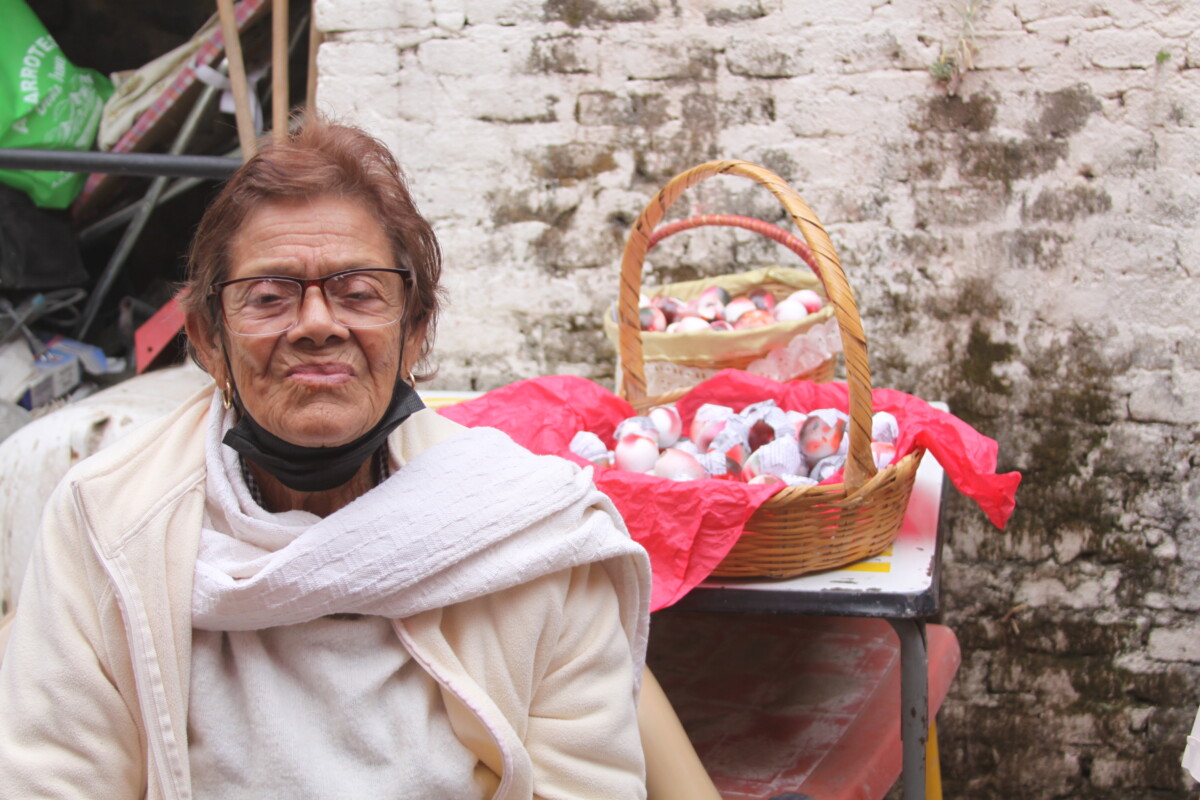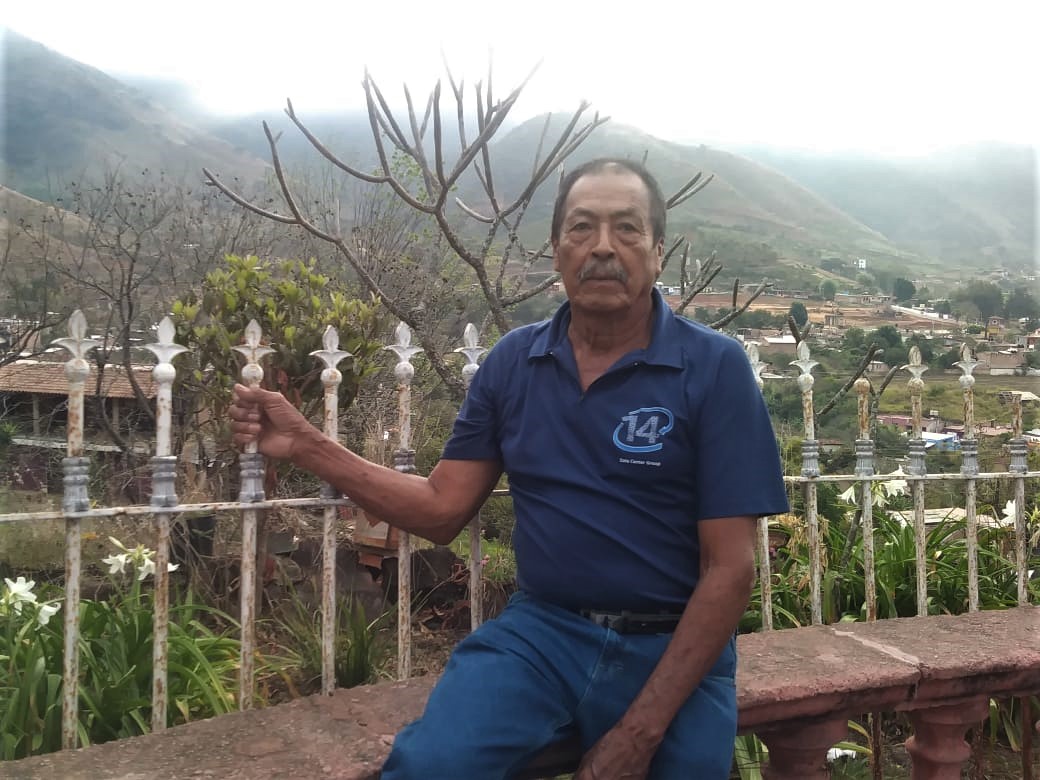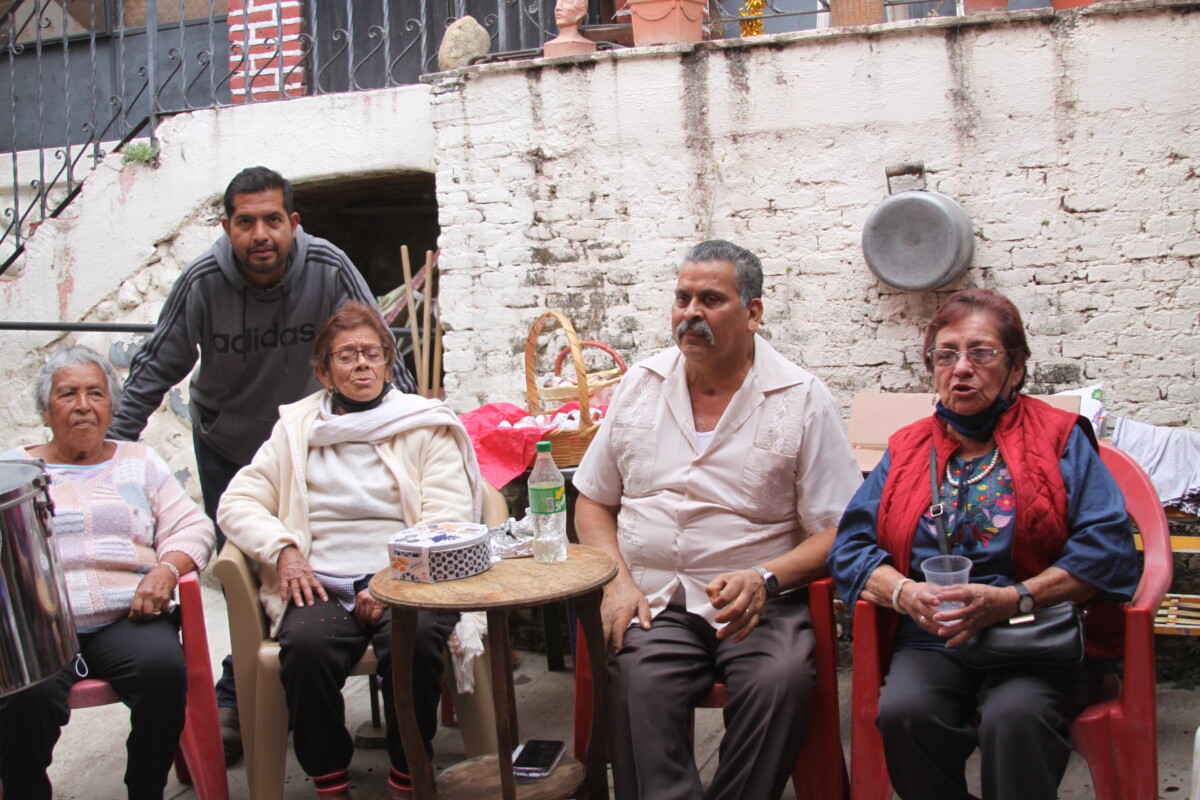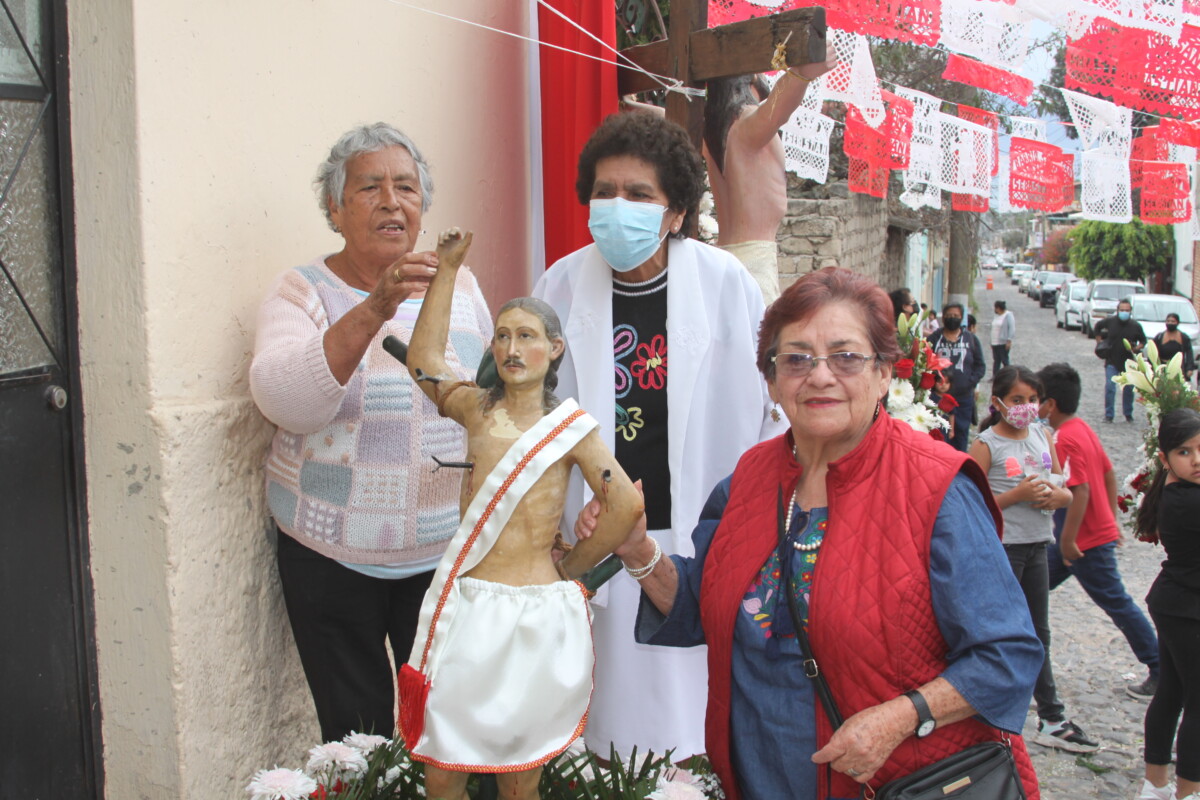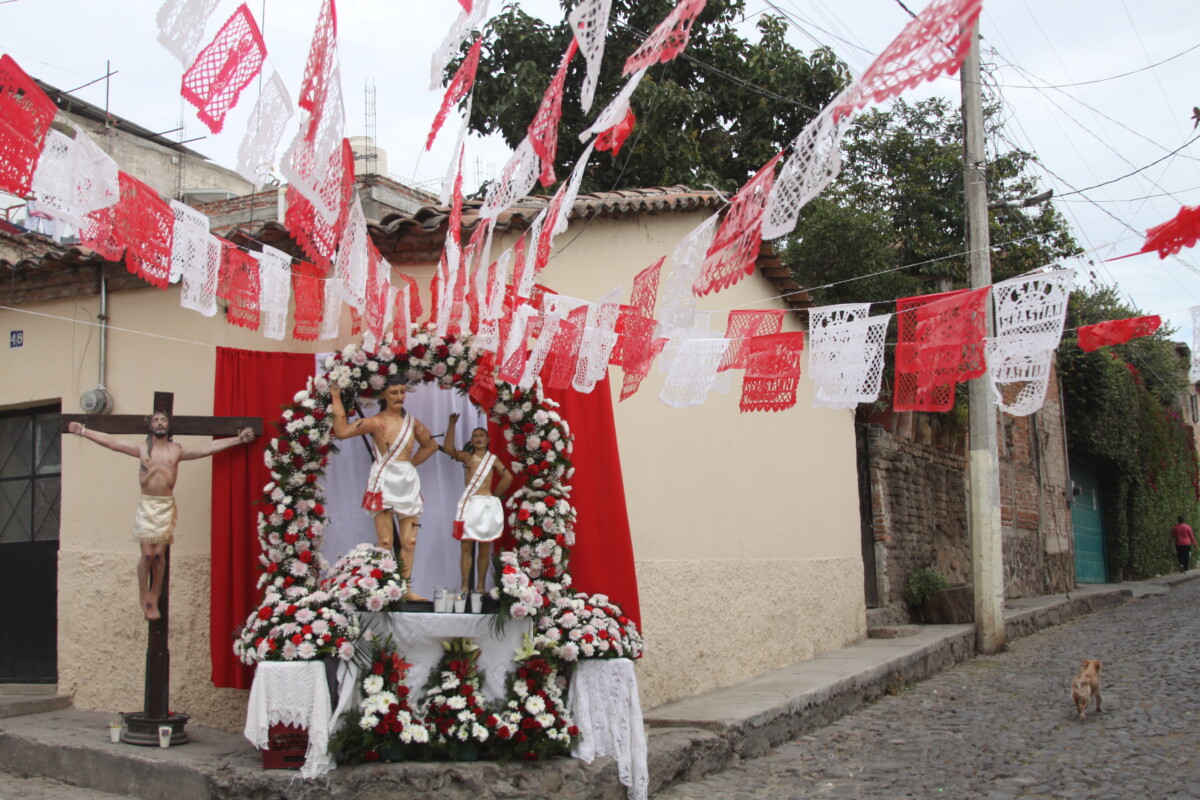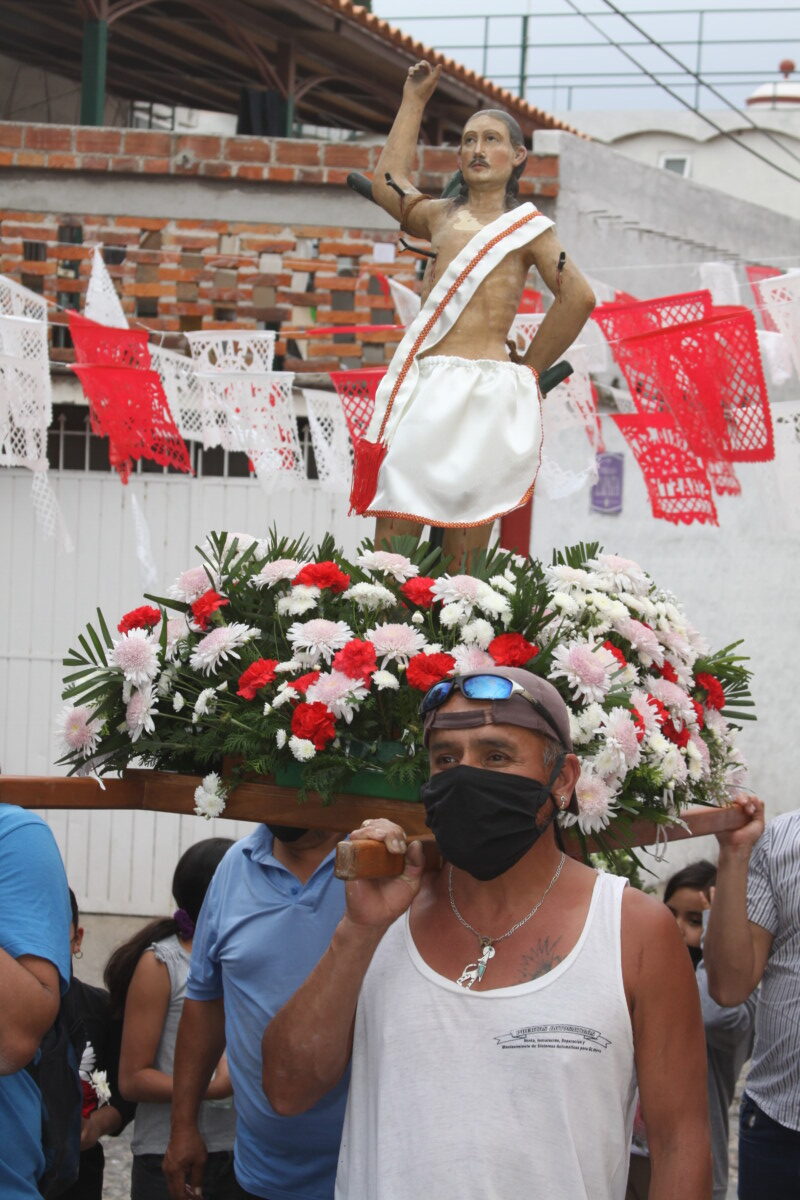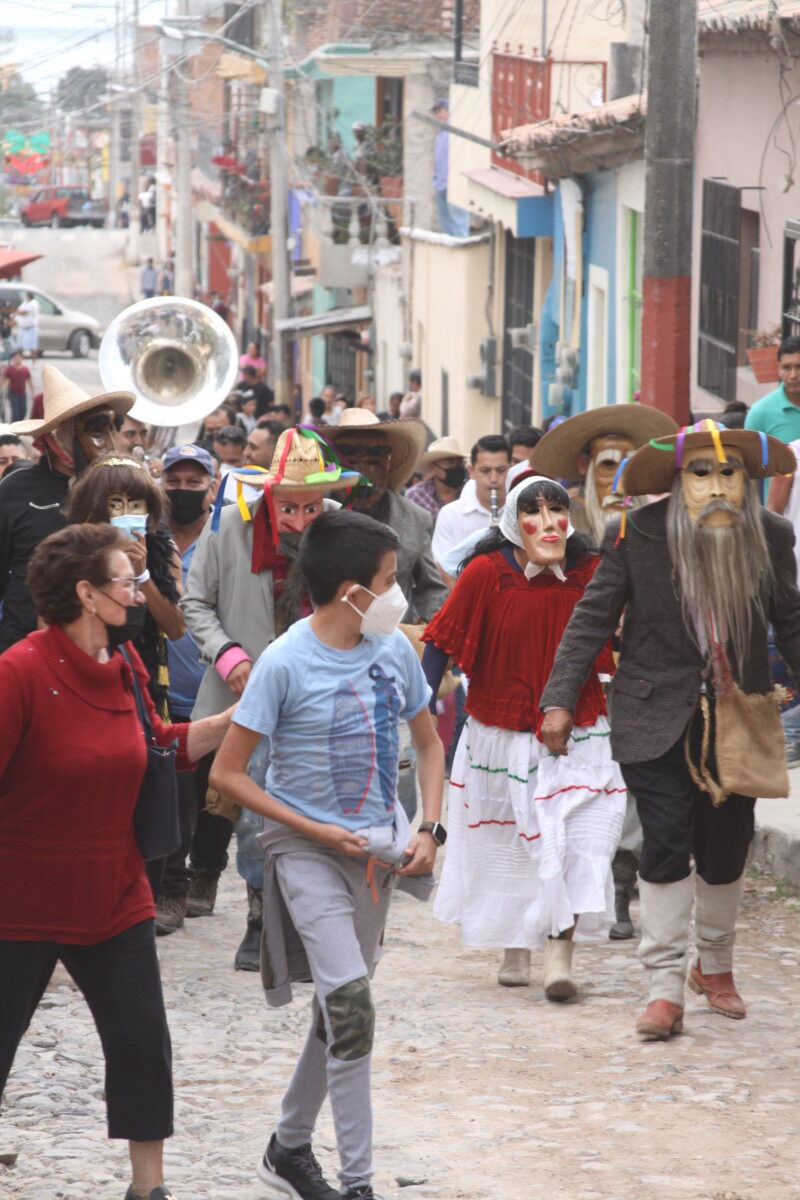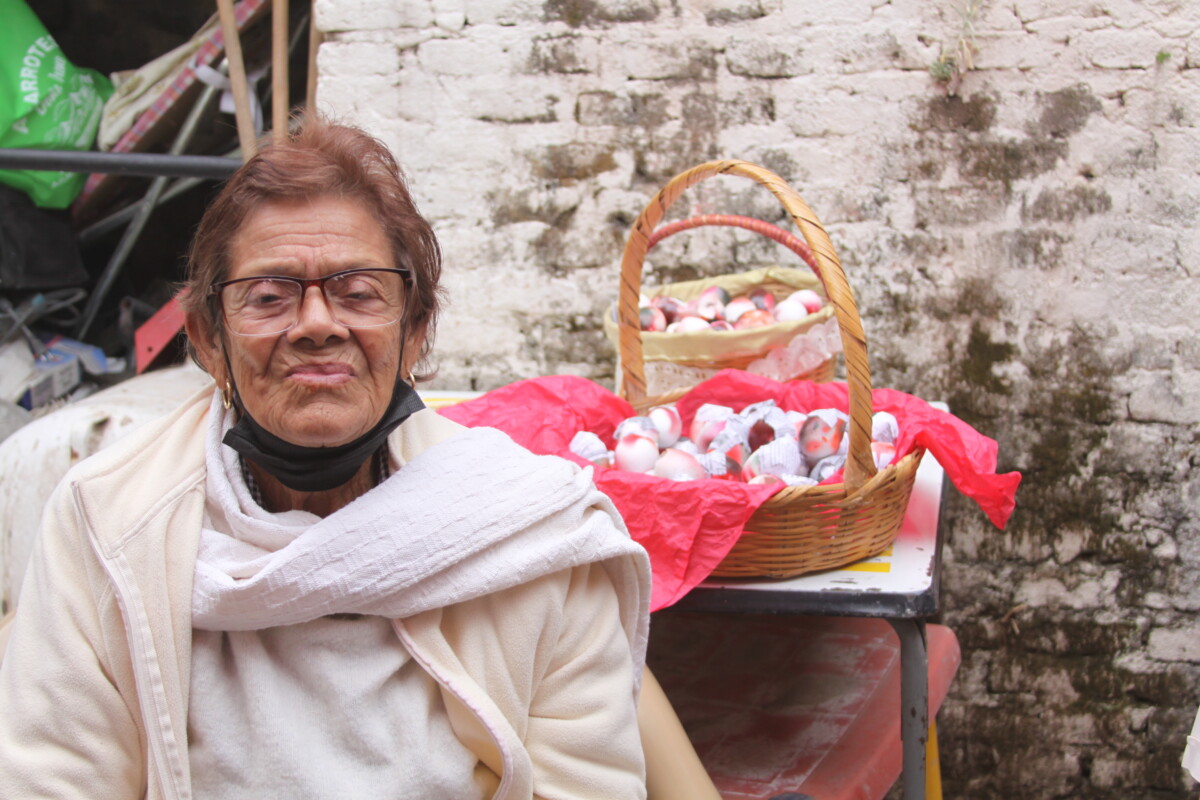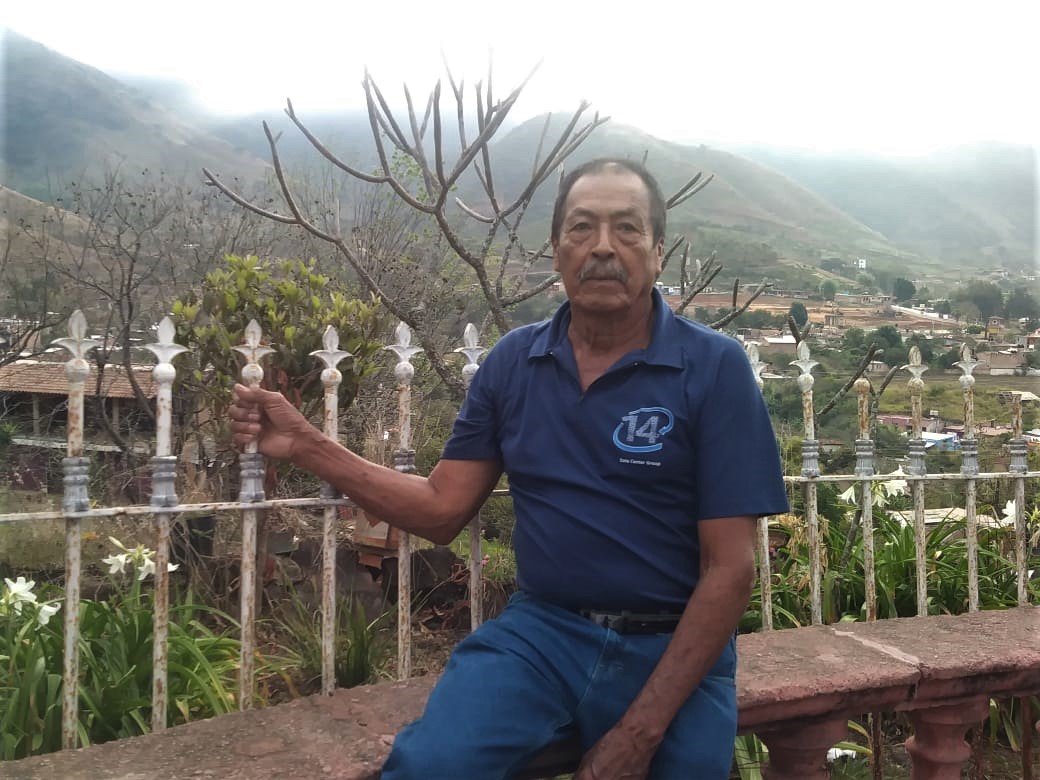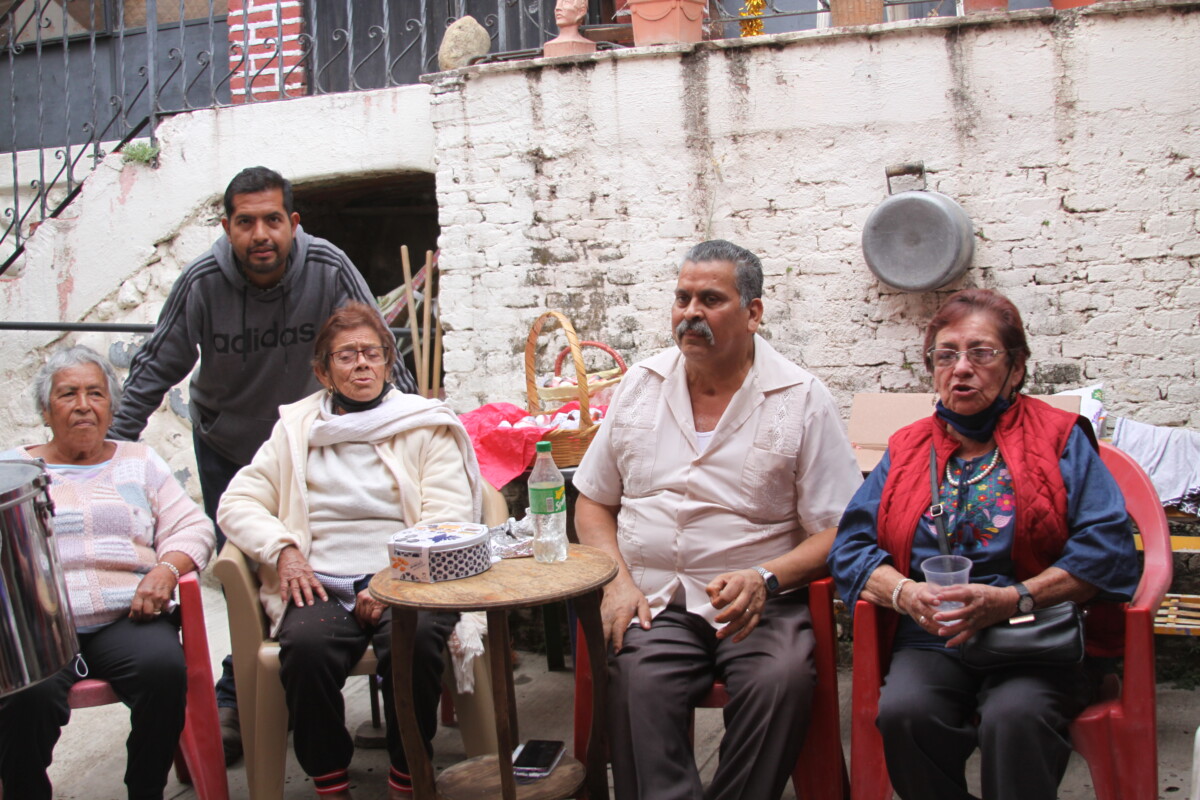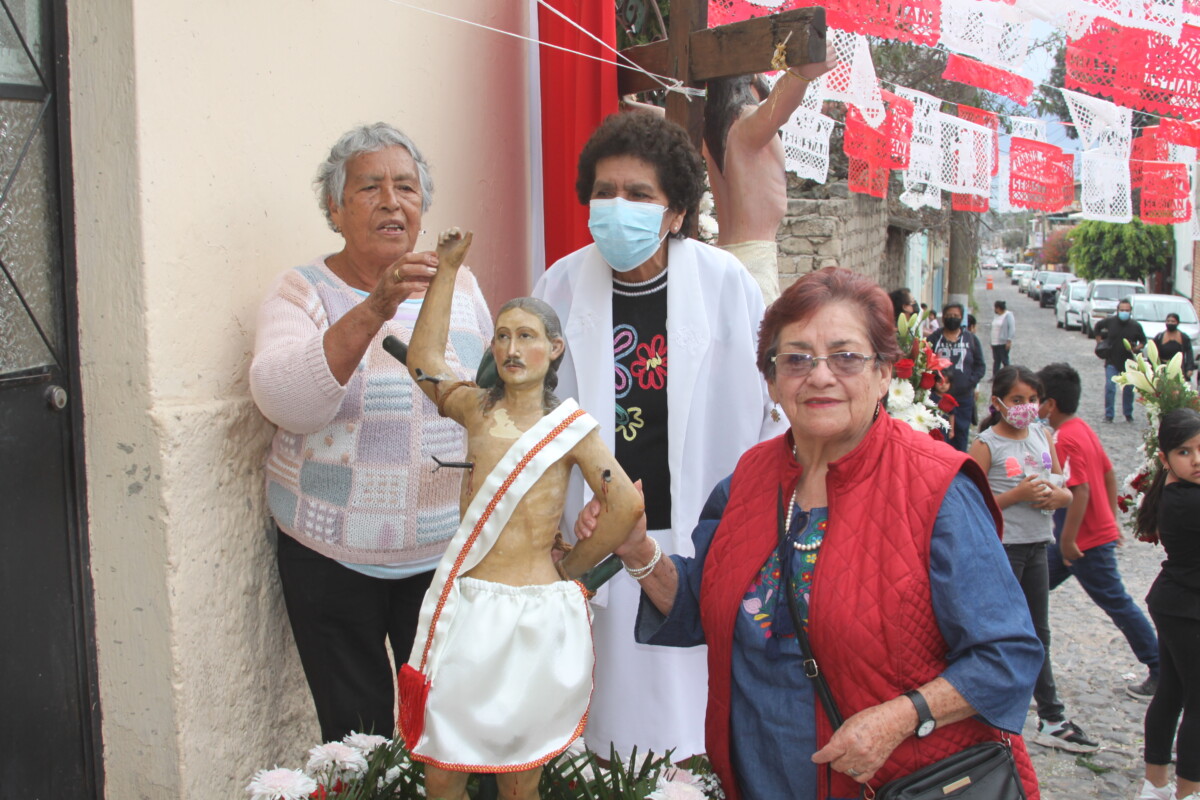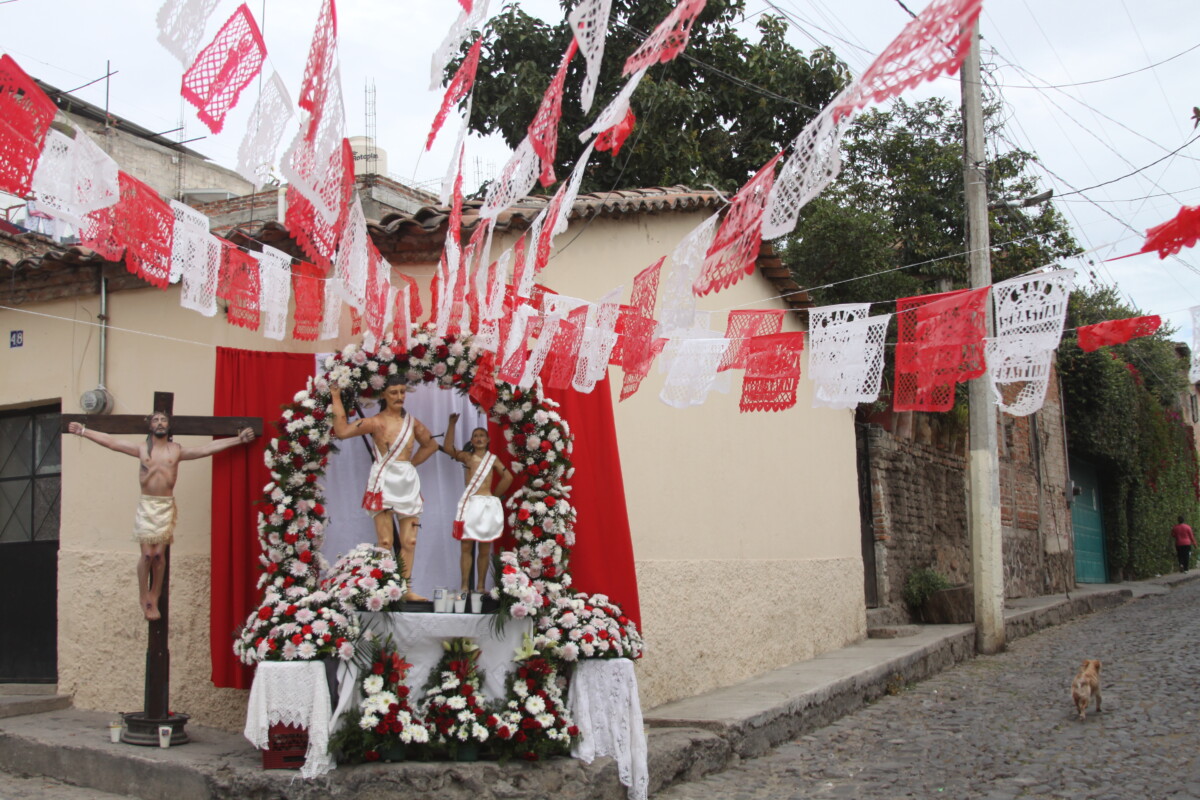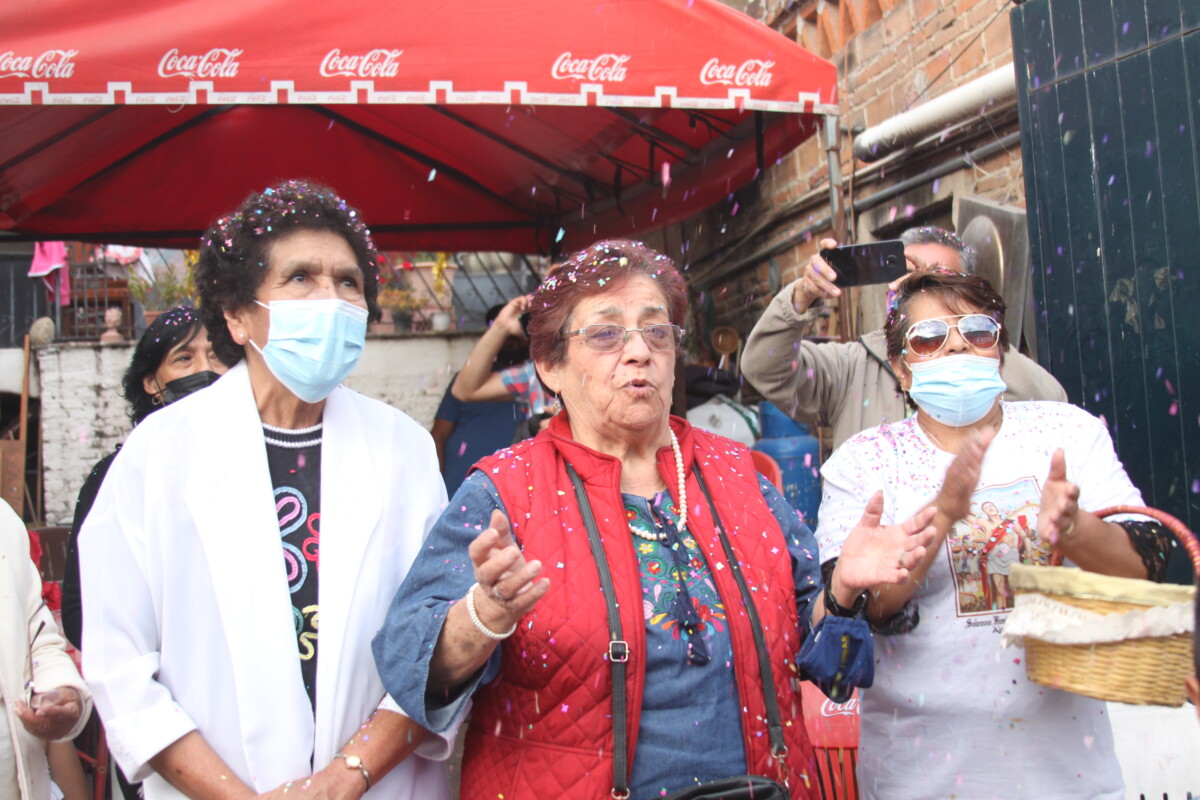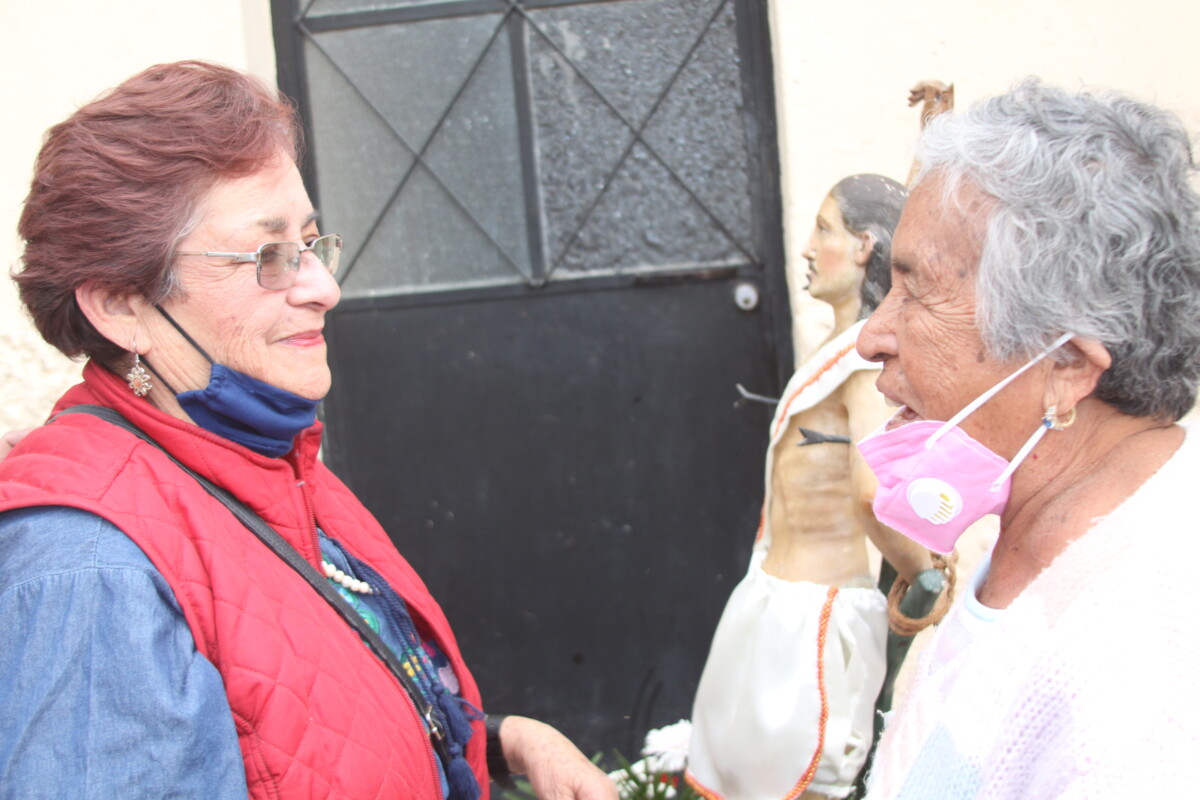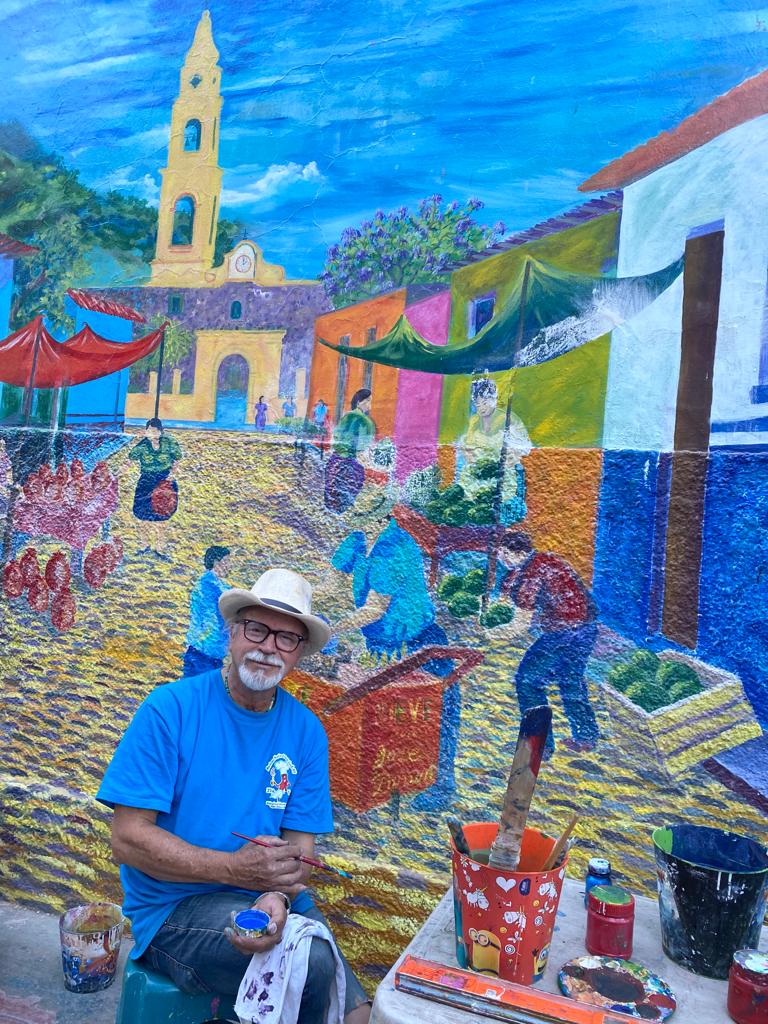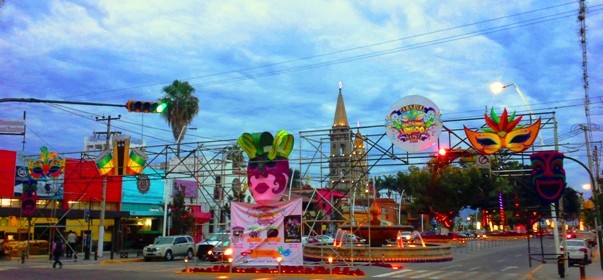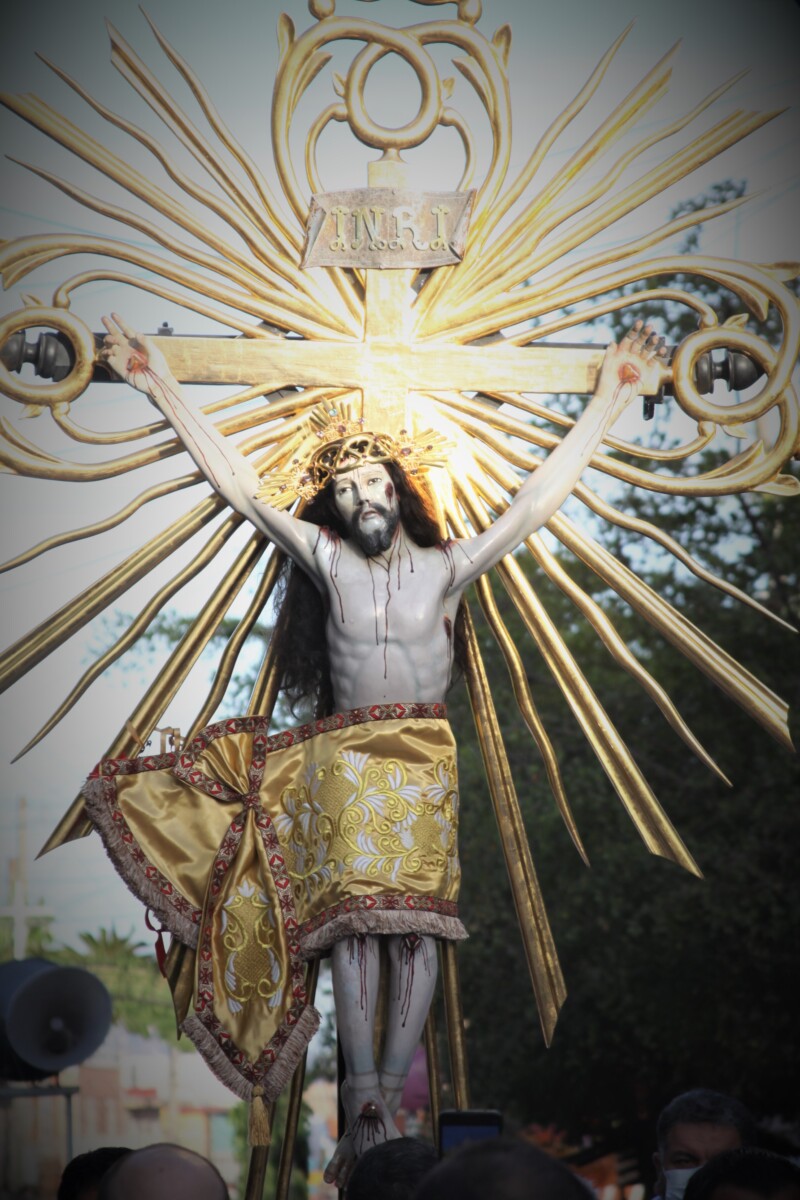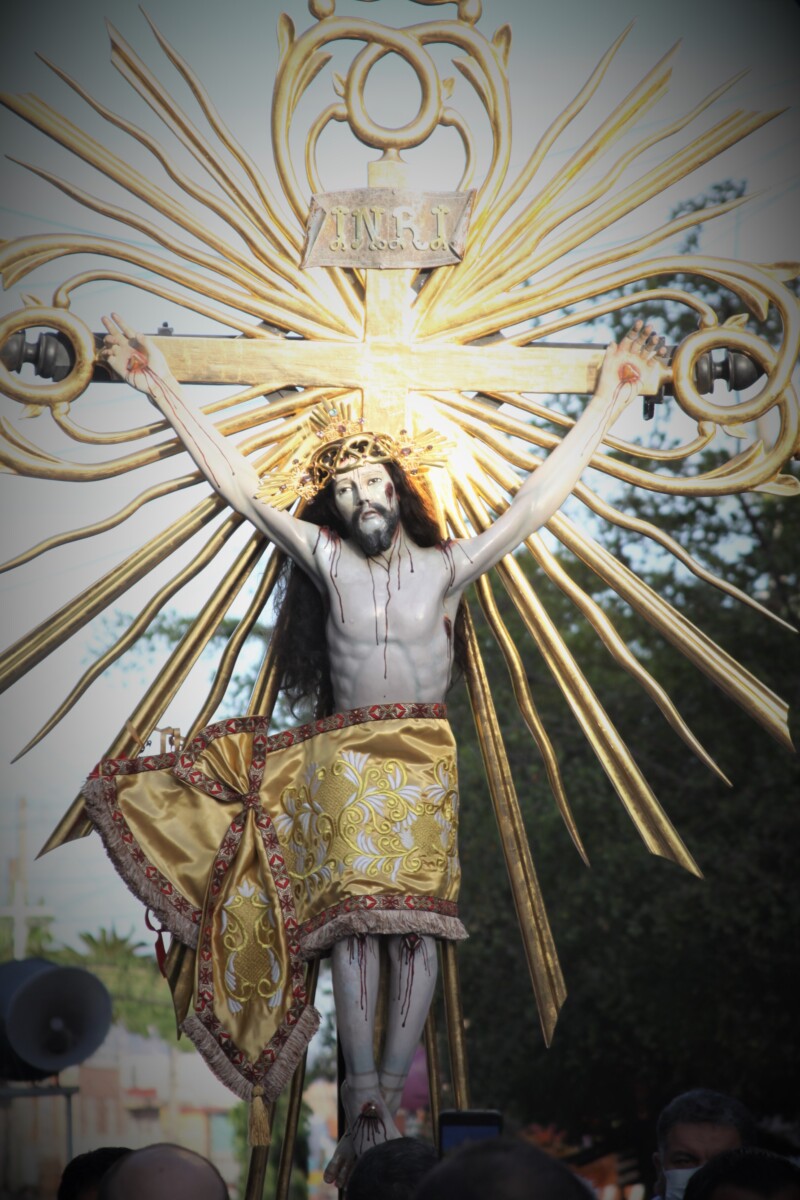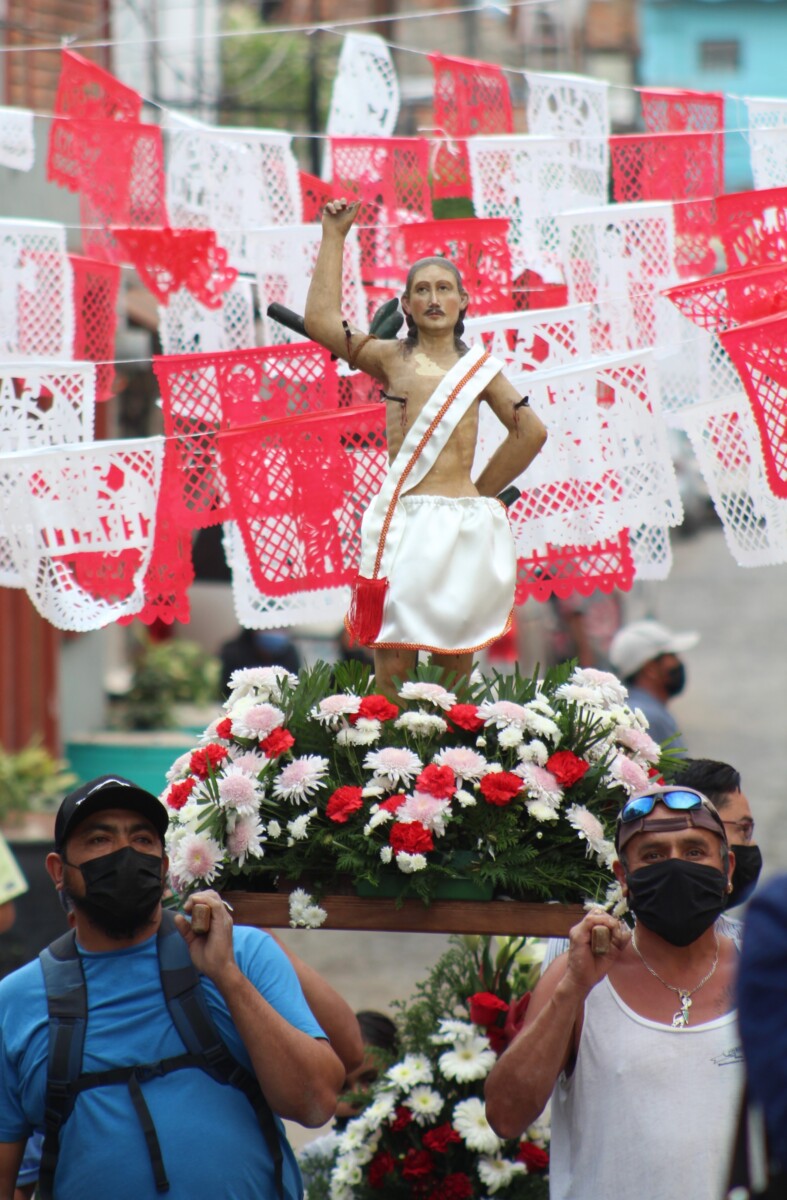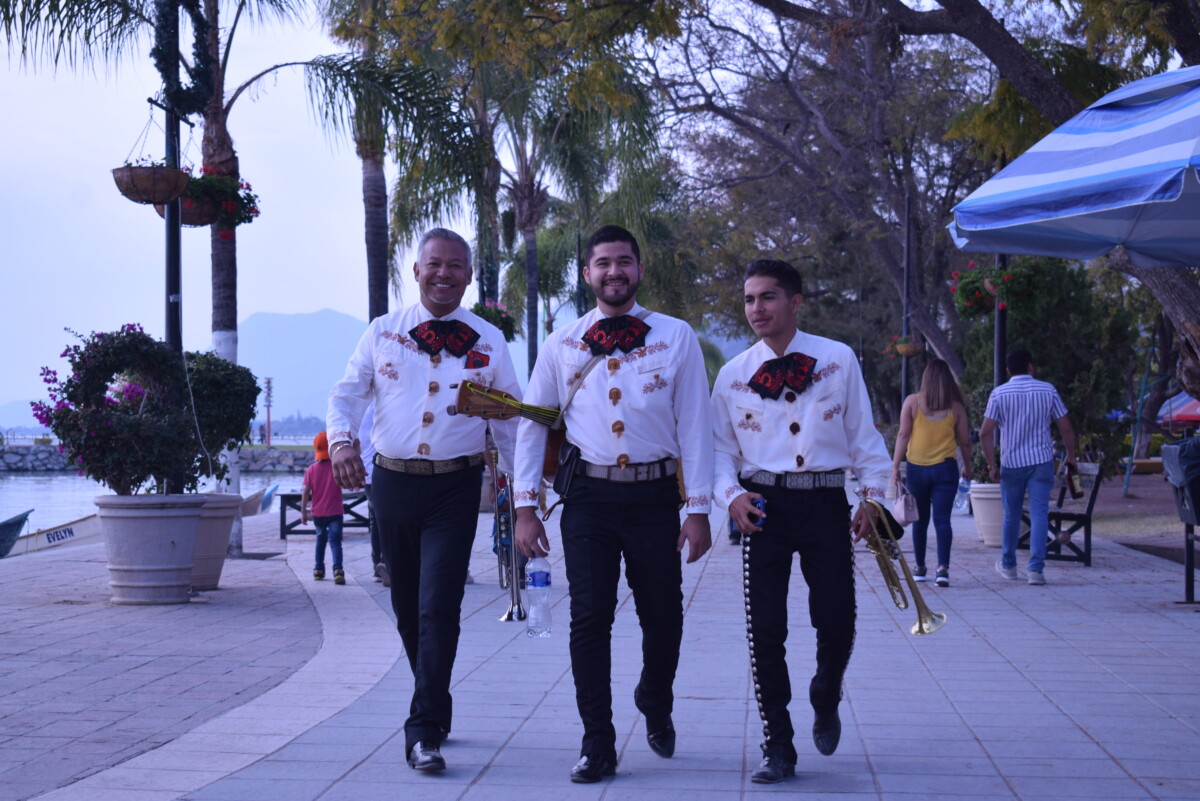tradiciones
Lakeside Chronicles: The feast of San Sebastian
Doña Irene prepared the eggshells with confetti weeks before
María del Refugio Reynozo Medina (Ajijic) – January 20 is the most awaited day for the devotees of San Sebastian.
Doña Irene is 82 years old. As a child, she accompanied her parents to the celebration of San Sebastian. She has lines of time on her face; most of them are hints of a smile, because Doña Irene smiles a lot. Her chatter is a contagious melody. She welcomes the visitor as if she had seen him yesterday and as if she already knew him. “Let’s have a little refreshment,» she says. Her conversation invites you to stay and contemplate the afternoon by the cobblestone street.
Although now it is not like other years, she is looking forward to the feast of San Sebastian with joy and she is providing almost 30 chickens for the mole.
Irene Martínez Cervantes lives in the San Sebastián neighborhood in Ajijic.
She remembers her parents’ veneration for the patron saint San Sebastian, whom they celebrated every year on January 20. Her family used to organize this celebration and she decided to continue it, despite the Covid-19 pandemic restrictions.
Seventy-five-year-old Don Antonio Arceo, another of the organizers, follows the tradition of his ancestors. He remembers that in the past, the sponsor of the festival was by invitation.
Two or three months before the festival, those who had been in charge the previous year would select another person to continue the tradition. The previous organizers would visit the new person, bringing a carafe of tamarind or pomegranate punch as a gift. They would bury the tightly closed punch for up to two months and add pieces of quince when it was unburied. When the drink was ready, the new sponsor agreed to assume the responsibility of covering the expenses of the drink, the food, the music and the tachihual bread (a traditional bread loaf). The new sponsor recruited ten to twelve people to help him. The following year he would make the same invitation to another acquaintance.
A handshake, a shared drink of punch and a word as a guarantee was enough to close the commitment. So says the song that is engraved in the memory of the faithful, by dint of repeating it every year during music and confetti.
This charge I give them
to those who remain.
So that they never forget it
and that they pay for it.
Weeks before January 20, Doña Irene starts to paint eggshells and fills them with confetti for the papaqui (the throwing of eggshells and confetti to the rhythm of the song of San Sebastian) That is why one of the mischievous stanzas says:
Poor San Sebastian
who never knew underpants.
The first ones he bought
he exchanged them for eggshells.
On the day of the procession Doña Irene is sitting inside the courtyard with some of her co-workers and close friends. She watches with pleasure the parade of men, women and children who come for the plates of food. Women and children carry towers of plates of mole, beans and rice to their homes. Some men take their rations and packages of tortillas to eat sitting on the sidewalks.
At the corner of Emiliano Zapata and Marcos Castellanos streets sits the altar to San Sebastian. There are two figures. The smaller one measuring approximately one meter and brought from the church the previous day. The other is one about a meter and a half that Doña Irene had sculpted. They are in the middle of a large arch of red carnations and chrysanthemums, on a table covered with white tablecloths.
“There are few people now,» says one of the attendants. Before the pandemic, food was served at tables set up along the street, and casseroles with rice and mole accompanied the procession.
Music has been playing since last night at San Sebastian. Not just one band, «it’s a group,» a young man tells me. Members of different bands come to play for the patron saint.
One woman and seven men make up the cast to liven up the procession. After three o’clock in the afternoon, they begin to prepare the small wooden platform where the smallest sculpture of San Sebastian, loaned from the parish, will be placed. He has starred in the festival for as long as they can remember.
Saint Sebastian is shown with one arm backwards tied to a pole and the other bent towards the heavens. His right index finger is missing. He has a taciturn look, curly shoulder-length hair, a mustache, thin outlined eyebrows and a cracked chest and arm. Five arrows are embedded in his body, which, according to the history of the saints, recall the rain of arrows he received in his martyrdom.
Doña Irene approaches with her companions to see him off, they surround him and talk in his ear, because he will not visit them again until next year. Little by little about 50 people arrive. The band begins to play. Suddenly the first sayaco (traditional, cross-dressing, masked characters who throw confetti or flour) appears wearing a work shirt, khaki colored jacket, boots, hat, and a backpack. He wears a long raw-colored wooden mask, from his cheeks emerges a long beard, bushy eyebrows and a straw-colored mustache.
Six more sayacos arrive dressed as exotic women. One of them, aided by a pair of balloons, shows off her bulging breasts under a flowered blouse. Another wears a blouse of gold and black threads with a tiara of sequins. The youngest sayaco looks like a teenaged girl wearing a scarf over her crimson-plated mask and a black dress edged with blue lace. She stomps her booties on the uneven streets.
The sayacos lead the procession dancing and waving their circular skirts non-stop, followed by the band. The sculpture of San Sebastian follows, carried on the shoulders of four men. As it passes through the elementary school, the students come out to watch through the entrance gate. The sayacos bring their masks close to the gate while the little ones laugh.
San Sebastian is returned to the parish amidst cheers and applause. The sayacos do not enter the temple and they wait outside to return in procession with the music of the band.
Now the Sayacos are the absolute masters of the parade, they take out fists of confetti from their backpacks to throw at the women. Up on a balcony a little girl hides between her mother’s legs, a sayaco jumps to scare her, the little girl cries and the woman laughs and hugs her. A group of about 30 children taunt the sayacos, run and urge them to chase them. Upon their arrival in the heart of the neighborhood outside Doña Irene’s house, the music continues to play and the Sayacos dance a little. Less than 30 attendees begin to break shells filled with confetti on their heads while the music plays. There Bertha Baron intones with two accompanists the traditional song to San Sebastian.
Say goodbye to the meat
and also to the sausage.
Because Ash Wednesday is coming
Ash Wednesday is coming.
And so, ends this celebration in which many collaborate, where adults play like children in a rain of confetti, all singing the traditional, fervent and irreverent song.
Translated by Nita Rudy
Crónicas de la Ribera
Doña Irene preparó semanas antes los cascarones con confeti.
Por: María del Refugio Reynozo Medina.
Tiene líneas del tiempo en su rostro; las más, como indicios de la sonrisa, porque doña Irene sonríe mucho. Su charla es una melodía que contagia; recibe al visitante como si lo hubiera visto ayer y como si ya lo conociera.
-Vamos tomándonos un refresquito- dice. Y su conversación invita a quedarse a contemplar la tarde al lado de la calle empedrada.
Irene Martínez Cervantes vive en el barrio de San Sebastián en Ajijic. Desde que era niña recuerda la veneración de sus padres por el patrono San Sebastián, a quien celebran cada año el día 20 de enero. Ellos organizaban esa fiesta y esta mujer decidió continuarla, aunque en este año con restricciones debido a la pandemia por Covid-19.
Don Antonio Arceo también es de los organizadores; sus antepasados lo eran. Tiene 75 años, recuerda que antiguamente, el cargo de la fiesta se tomaba por invitación.
Desde dos o tres meses antes, quienes habían sido encargados el año anterior, pensaban en otra persona que pudiera continuar y la visitaban, llevando de obsequio una garrafa con ponche de tamarindo o de granada.
En aquel tiempo, sepultaban el ponche hasta dos meses debajo de la tierra bien cerrado. Luego lo sacaban y le agregaban trocitos de membrillo.
Ya entrados con el trago, los invitados aceptaban asumir el cargo que implicaba los gastos de la bebida, la comida, la música y el pan tachihual embetunado.
La persona debía buscar a diez o doce más para que le ayudaran. Y al año siguiente hacía la misma invitación a otro conocido.
Bastaba un apretón de manos, un trago de ponche compartido y la palabra como garantía para cerrar el compromiso. Así dice el canto que está grabado en la memoria de los fieles, a fuerza de repetirlo cada año en medio de la música y los confetis.
Este cargo se los entrego
a los que vayan quedando.
Para que nunca lo olviden
y que lo vayan pagando.
El día más esperado para los devotos de San Sebastián
Semanas antes del 20 de enero doña Irene se puso a pintar cascarones de huevo y a rellenarlos con confeti, para el papaqui (El lanzamiento de cascarones y confeti al ritmo del canto de San Sebastián y demasiadas carcajadas). Por eso una de las estrofas matizada de picardía dice:
Pobre de San Sebastián
que no conoció calzones.
Los primeros que compró
los cambió por cascarones.
Aunque ahora no es como otros años, espera con alegría la fiesta de San Sebastián, también la espera con casi 30 pollos para el mole.
A mi llegada, encuentro mujeres y niños llevando para sus casas torres de platos con mole, frijoles y arroz. Algunos hombres toman sus raciones y paquetes de tortillas para comer sentados en las aceras.
En la esquina donde convergen las calles de Emiliano Zapata y Marcos Castellanos, está instalado el altar a San Sebastián; hay dos figuras, la más pequeña que mide aproximadamente un metro y que trajeron desde el día anterior de la parroquia; y una más como de metro y medio que doña Irene mandó esculpir. Están en medio de un nutrido arco de claveles rojos y crisantemos, sobre una mesa forrada con manteles blancos.
-Ahora es poca gente- dice uno de los asistentes. En otros tiempos sin pandemia, la comida se servía en mesas instaladas a lo largo de la calle, y las cazuelas con arroz y mole acompañaban a la procesión.
Doña Irene está sentada al interior del patio con algunos de sus colaboradores y amigos cercanos; observa complacida el desfile de hombres, mujeres y niños que acuden por los platos con comida.
Están aquí algunos instrumentos de los que tocaron desde anoche a San Sebastián.
No es una sola banda, “es un rejunte”, me dice un muchacho. Miembros de distintas bandas que tuvieron voluntad de venir a tocarle al patrono. Una mujer y siete varones componen el elenco para amenizar la procesión.
Pasadas las tres de la tarde, comienzan a preparar la pequeña plataforma de madera donde va San Sebastián, la escultura más pequeña que les prestan en la parroquia y que ha protagonizado la fiesta desde que tienen memoria.
San Sebastián aparece con un brazo hacia atrás atado a un poste y el otro flexionado hacia el firmamento; le falta el dedo índice derecho que estaría apuntando al cielo. Tiene una mirada taciturna, pelo rizado al hombro, bigote, finas cejas delineadas y el pecho y brazo resquebrajado. Lleva cinco flechas incrustadas en el cuerpo, que recuerdan según la historia del santoral la lluvia de saetas que recibió en su martirio.
Doña Irene, se acerca con sus acompañantes a despedirlo, lo rodean y le platican al oído, porque las volverá a visitar sólo hasta la vuelta de año.
Poco a poco comienza a llegar la gente, son poco más de 50 los que componen la caravana. La banda comienza a tocar.
Aparece de pronto el primer sayaco con una camisa de caporal y un saco color caqui; botas, sombrero y un morral terciado. Lleva una máscara larga de madera color crudo; de sus mejillas emerge una larga barba, lleva pobladas cejas y bigote color paja.
Llegan seis más, caracterizados de exóticas mujeres; una de ellas auxiliada por un par de globos, presume unos abultados senos debajo de una blusa de flores. Otra lleva una blusa de hilos dorados y negros con una tiara de lentejuelas.
El sayaco más joven, parece un adolescente; caracterizado de muchacha, lleva una pañoleta sobre su máscara acartonada con chapitas carmesí y un vestido negro bordeado de un encaje azul. Zapatea fuerte con los botines sobre las calles desiguales.
Los sayacos encabezan la procesión bailando y ondeando las faldas circulares sin parar, seguidos por la banda. Y al final va la escultura de San Sebastián cargada por cuatro hombres. A su paso por la escuela primaria, los alumnos salen a observar a través del cancel de ingreso, los sayacos les salen al paso y acercan sus máscaras mientras los pequeños ríen a carcajadas.
San Sebastián es devuelto a la parroquia en medio de vivas y aplausos de unos diez peregrinos. Los sayacos no ingresan al templo, esperan afuera para regresar igual en procesión con la música de la banda.
Ahora los sayacos son los dueños absolutos del desfile, sacan de los morrales puños de confeti para lanzar a las mujeres. Arriba en un balcón una niña se esconde por entre las piernas de su madre y el sayaco salta para asustarla, la pequeña llora y la mujer ríe y la abraza. Un grupo de unos 30 niños burlan a los sayacos, corren y los instan a que los persigan.
A su llegada en el corazón del barrio afuera de la casa de doña Irene, la música sigue tocando y los sayacos bailan un poco, los asistentes que no llegan a 30, comienzan a romperse cascarones con confeti en la cabeza mientras la música toca. Ahí Bertha Barón entona con dos acompañantes el tradicional canto a San Sebastián.
Despídanse de la carne
y también de la longaniza.
Porque ya se está llegando
el Miércoles de Ceniza.
Y así termina esta celebración en la que colaboran muchos y en donde los adultos juegan como niños en una lluvia de confeti, con un canto entre fervoroso y pagano porque esta fiesta es así.
Popular Ajijic mural gets a facelift
José Durán retouching of his iconic mural on Morelos Street in front of the Malecón.
Sofía Medeles – Based on the number of tourist photos, one of the most recognized spots in Ajijic is the corner of Morelos at its intersection with Del Paseo; right in front of the pier. Murals and reliefs by José Durán, Javier Zaragoza, Ramón Heredia and Jesús López Vega attract throngs of picture-snapping tourists and locals daily.
Recently, the popular Ajijic Tango restaurant moved to this spot and asked the artists to maintain their murals, among them, José Durán who painted the landscape on the building. After 13 years, his idyllic scene which depicts the daily life and customs of Ajijic was finally retouched.
José Durán’s creation is now finished and in it you can see scenes of Colón Street, a tianguis that was located on Parroquia Street, and a couple listening to musicians sitting on the iconic tree of the six corners.
Next to it, on the same property, there is a mural by Javier Zaragoza, a relief by Ramón Heredia, and on Del Paseo Street, a mural by Jesús López Vega, which is also being restored.
Translated by Patrick O’Heffernan
Loudspeakers in Ajijic plaza repaired after several years of neglect
One of the loudspeakers located in the main square, in front of the kiosk.
Sofía Medeles (Ajijic, Jal.)- The speakers in the main square of Ajijic are singing again. This Monday, January 17, the two loudspeakers in front of the kiosk were repaired early in the morning, and by midday they were already playing melodies.
The Ajijic Delegado, Maximiliano Macías Arceo, said that the speakers had been in bad condition, with nests of insects inside. He is not sure how long they had been out of order. He said that they have been repaired and cleaned inside and out, which he believes was the first time in several years. «When we took them down, they were almost stuck together,” he said and then added that the Municipality of Chapala paid for the expense.
As for the programs broadcast, he said that they will mainly be radio stations like Fórmula Melódica, La Buena Onda, Radio Gallito, EXA FM, and others. «We may use them to broadcast announcements from the delegation or other presentations. We are waiting for instructions from the president on how to use them in the best way.”
The arrangements were well received by the residents who usually pass through or stay in the plaza. «It feels like before, it’s nice to listen to the radio, because sometimes in other locations you can’t get a good signal, here you can, and you can hear it very well. I came to eat my peanuts and sit down for a while to talk about the news,» said Don Nico, who usually goes to the plaza in the mornings.
The tentative schedule will be from 9:00 am to 4:00 pm. To date they have received positive comments from the villagers.
Translated by Nita Rudy
Requested approval from the Jalisco Health Board to hold the Chapala Carnaval
The last Carnaval celebrated in Lake Chapala was in 2020. Photo: Archive.
Jazmín Stengel. Despite the pandemic, the Mayor of Chapala Alejandro Aguirre Curiel has requested approval from the Jalisco Health Board to hold the Chapala Carnaval, beginning at the end of February and running through early March.
After a two year absence, the City Council has decided to grant planning of the Chapala Carnaval to individuals to organize the festivities this year. «The idea is that it will be done externally with support from the municipality,» municipal president Alejandro Aguirre said. He added that a group of people has expressed interest in taking on the responsibility.
While public gathering restrictions issued by the Health Board of Jalisco will remain valid until February 12, the Municipality of Chapala has applied for and is awaiting the necessary permit to hold the festivities. In this respect, Aguirre reflected: «we have to learn to live with it (Coronavirus), since we are all exposed.»
Translated by MaryAnne Marble
San Sebastián ceremony returns with lively religious celebrations
Entrance of the procession to the parish of San Andrés Apóstol, where the image of the saint was finally left
Sofía Medeles (Ajijic, Jal.)- Although San Sebastián was celebrated with a very modest ceremony, the neighbors of the neighborhood did not miss the opportunity to celebrate the saint with a mass in the neighborhood located in the north of Ajijic, sharing hot chocolate and bread, and in the afternoon, with a small procession to return the religious figure, enlivened with a musical group and the traditional masked sayacas.
«The celebration was good. It was a little smaller than other years, but it felt just as nice,» said one of the participants.
The January 20 mass was celebrated in the neighborhood of San Sebastian, as it is the one day of his feast.
During the morning, the mass was attended by no more than 50 people and all of them respected at all times the health protocols in force. At the end, chocolate, cinnamon and tachihual bread were distributed to the participants of the Eucharistic ceremony. «It was good, it was small, unlike other years, but it felt just as nice,» said Don Antonio, a close neighbor of the neighborhood.

The neighbors of the neighborhood did not miss the opportunity to celebrate the saint with a mass in the neighborhood located in the north of Ajijic.
Later, during the procession, more people -approximately 70 people- could be seen. The procession began with the sayacas dancing, while behind them was a musical group, and at the end, San Sebastian, carried by four men.
Throughout the procession there was a group of children looking to be chased and floured by the sayacas. The sayacas danced, while all around them spectators enjoying the festivities and filming the scene.
«This is what one likes. There have already been so many big celebrations, like the one in Jocotepec. I don’t think there will be a fuss about this. There are only neighbors here and we are all wearing our masks. We had the pleasure of being together and also sharing a beer,» said Don Nico, minutes before the procession began.

During the celebration, a couple of tourists joined the dance of the sayacas that accompanied San Sebastian on his route through some of the streets of Ajijic
Although the route changed a bit –through Zapata, Javier Mina, Guadalupe Victoria, a lap around the plaza, and finally Parroquia street—San Sebastian was accompanied by spectators all the way. In the plaza, a couple of excited tourists joined the procession to dance to the music of the band.
«We didn’t imagine there was going to be a parade, we just came to walk around because there was an opportunity. We didn’t know San Sebastián, much less imagine that here in the Pueblito Mágico he is so beloved,» mentioned a man who was sitting in the plaza.
In the end, only those carrying the image entered the parish of San Andrés Apóstol where the saint was taken, as well as a few companions, while the sayacas remained at the entrance of the parish, and the band played the mañanitas outside the temple. After leaving him, the people returned to the neighborhood of San Sebastian, located to the north of Ajijic.
Translated by Sydney Metrick
Lakeside Chronicles
The Señor del Monte religious festival has filled the streets of Jocotepec for more than 180 years on the third Sunday of January.
By María del Refugio Reynozo Medina
That time long ago, we could not even reach the threshold of the parish; Juan Pablo and I got lost in the human tide that swirled around the statue of the Señor del Monte. We were going against the current; after the rubbing of sweaty bodies in which we could even feel each other’s ribs, we returned to the little truck that had taken us there and was about to leave us. We could not see the Señor del Monte.
More than 20 years have passed since that day. Today, half an hour before the start of the procession, the atrium begins to receive the pilgrims who continue to arrive, but do not flood the enclosure. According to some parishioners, this year there was half the attendance compared to the years without the Covid-19 pandemic. Some five thousand people this year, according to data from the Civil Protection Office of the municipality of Jocotepec.
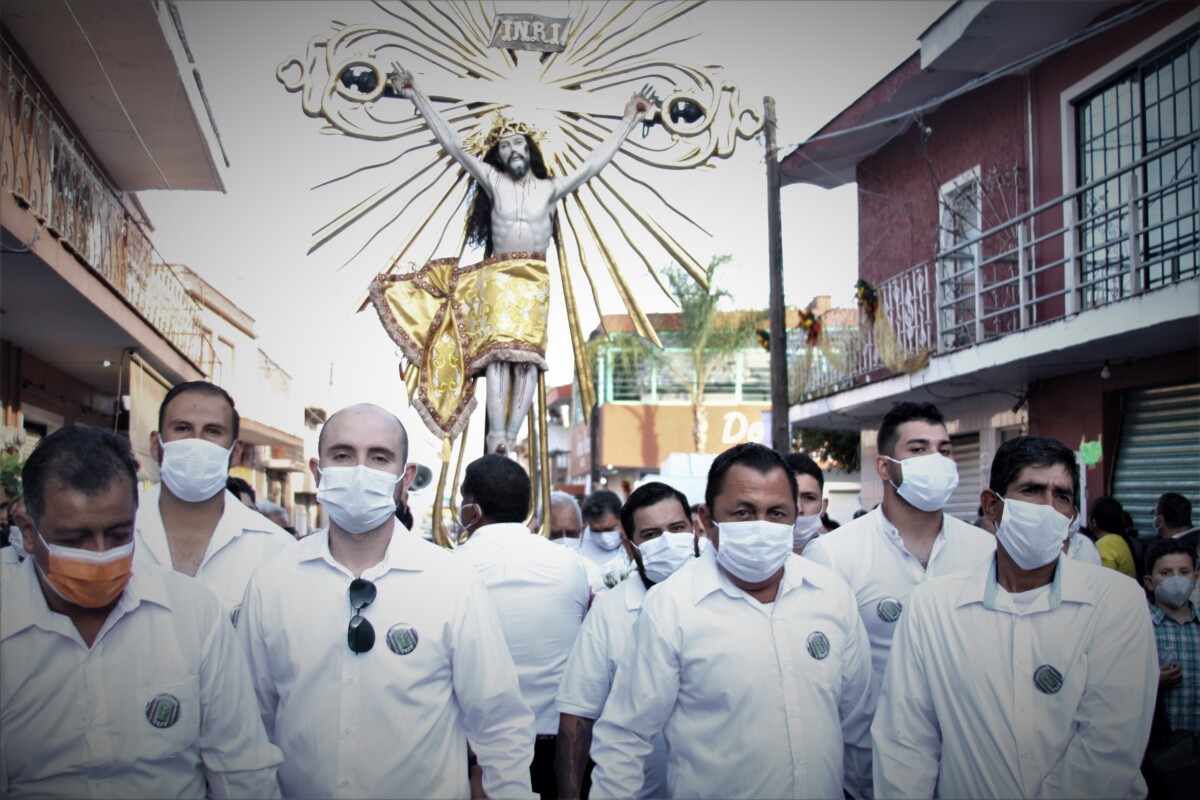
The positions of the honor guard are inherited from generation to generation to the firstborn.
In the temple, the members of the honor guard are already behind closed doors preparing the Señor del Monte for his journey, as has happened every third Sunday of January for more than 180 years.
The Jocotepec chronicler Manuel Flores Jiménez, marks the year 1834 as the first occasion that the ancestors celebrated his «miracle,» then November 8, 1833, as the date in which they also congregated, to swear in writing to take him as the patron saint of their lives. In 1918 the oath was renewed.
The honor guard is composed only of men, all direct descendants of those who took the original oath. There are about 150; most are adults, the youngest is 11 years old. They are grouped by families, each one with a specific task such as organization, preparation of the image for its journey and care and custody of the patron during the procession.
Belonging to the honor guard is a privilege that is inherited from generation to generation and becomes a gift that arrives by destiny.
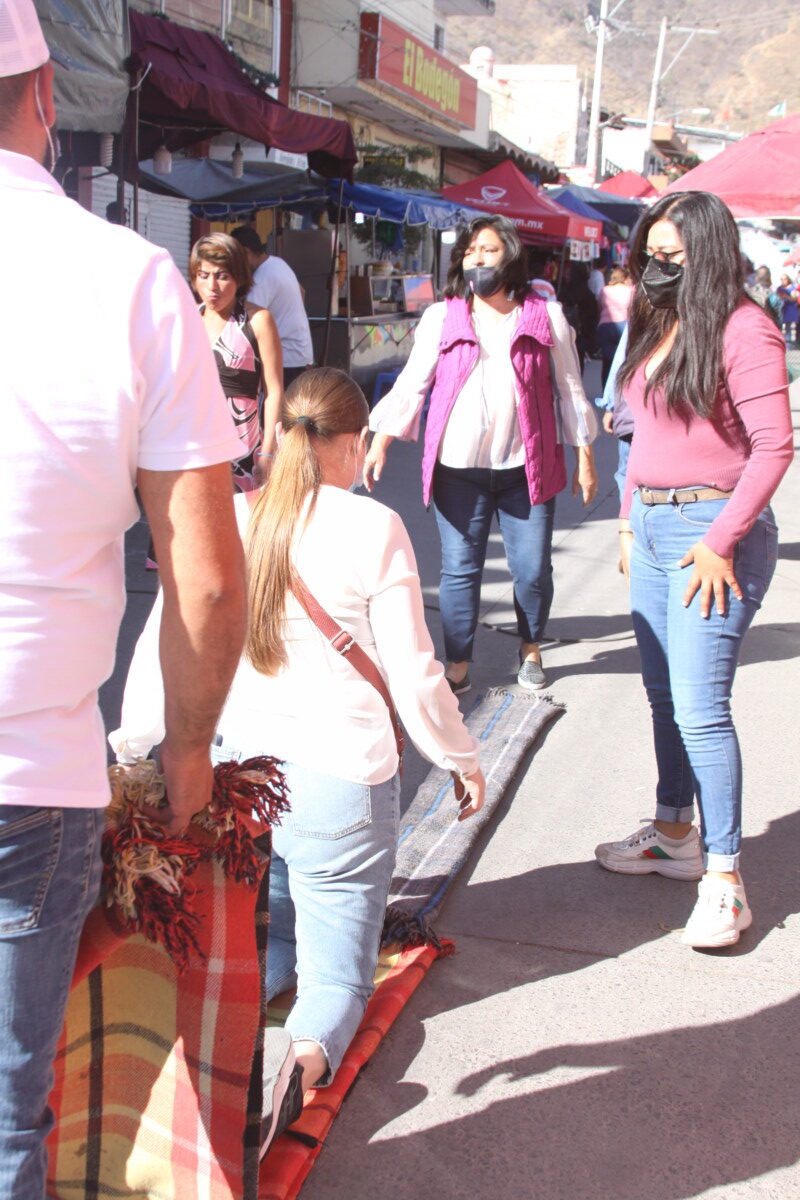
Some people advance to meet the procession kneeling to give thanks for favors received or to ask for help from the Señor del Monte.
The men of the honor guard are dressed in white shirts, surrounding the image that has already been taken down from the altar, and finish preparing it for its procession. There are few women in the place; not even ten, they are direct relatives of the members of the honor guard. It was not until about ten years ago that women were allowed to enter.
The Lord of the baptistery is already downstairs, as his ancestors called him before he became their official patron saint, according to the records of the chronicler Flores Jiménez.
The Christ directs his gaze to the sky with half-open lips, has a sharp nose, beard and black hair. He has his arms extended on the wooden cross that appears to shine; that cross «morena de sol» as father Benjamín Sánchez calls it in the Romancero de la vía dolorosa, is bordered with golden rays.
The Señor del Monte wears a coppery cloth with rich embroidery, and on his head, a splendorous crown made of prayers always heard, because «this Lord is very prodigious.»
“I am one of his miracles,» says Manuel Ibarra, who emerged victorious from a cancer diagnosis. Before going to the hospital, he prayed to the Señor del Monte for his health and touched the body of the Christ figure with a piece of absorbent cotton, to carry it with him in the battle against the disease. That was 12 years ago.
Jésus Pérez is the grandson of Cándido Pérez, the latter was present at that historic oath and appears in a painting, «The Oath» which is in the sacristy of the parish. Now Mr. Jésus participates with his son Óscar Pérez and his grandson Alejandro Pérez.
Minutes away from the beginning, the bells toll with a festive flavor, a human fence begins to form and dozens of eyes look anxiously at the huge wooden door.
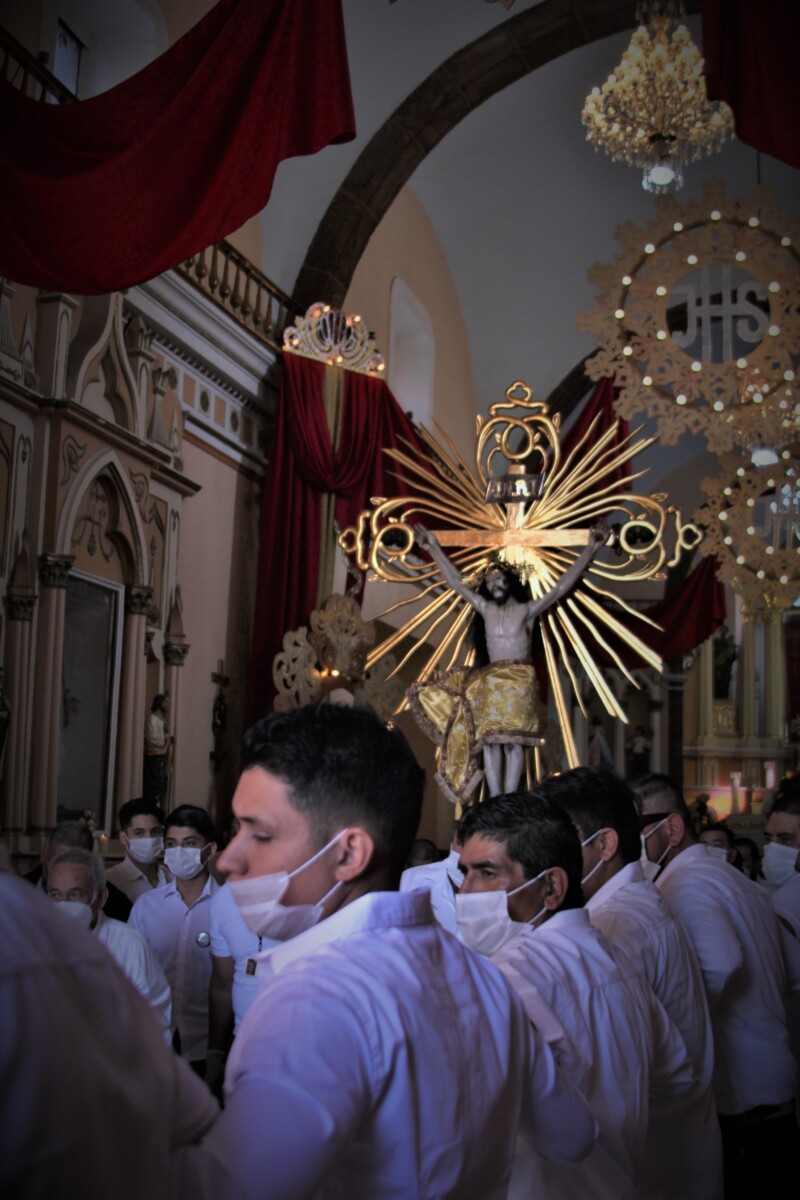
The men of the honor guard intertwine hands to leave the temple with the image at the beginning of the procession.
-Long live the Señor del Monte!» shouts a man’s voice, seconded by another female voice.
-Long live! ¡Viva!
The fervent voices respond and the door opens.
The faithful crowd moves to meet the crucified Christ. The drums of the dancers sound and the pilgrimage begins.
Leading the procession is a girl of about five years old dressed as a dancer, she emulates the steps of her elders and glides safely across the width of the street.
A man and a woman wear white t-shirts with «Danza por manda» written in black letters. With them are more people who dance throughout the procession in orderly rows. There is also the marching band, a young man on stilts who helps with the order of the walkers, and a mariachi band.
A female voice prays the rosary and sings over a loudspeaker from a cart.
Some streets are adorned with bows of red and yellow satin ribbon, also with arches of fresh flowers.
The Señor del Monte is carried by a guard of 20 men, one of them walks backwards, every so often along the way they are exchanged for another group of 20. Five guard changes are made along the pilgrimage, in total there are one hundred men who help carry the patron saint.
«Vivas!» to the Señor del Monte are heard along the route, tearful eyes seek the face of the crucified, there are many tears shed, many prayers in silence, which are announced by the tearful look of those who come out in their path.
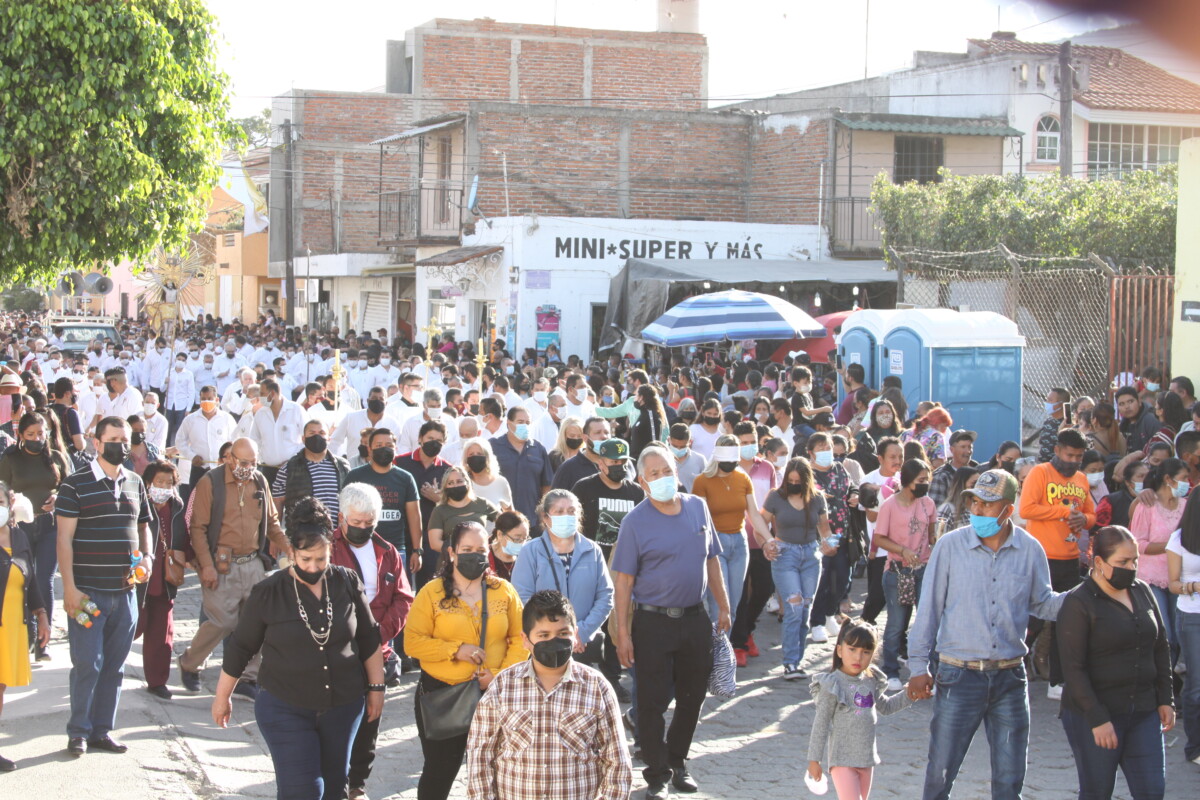
With the attendance of about five thousand people, according to data from the Civil Protection Department of Jocotepec, the procession in honor of the Señor del Monte took place.
Some people go barefoot and blindfolded; a line of men and women who advance kneeling in the opposite direction to the procession, go to meet the image, supported by folded blankets thrown on the floor.
Civil Protection officers watch over those who are kneeling and help them to get back up.
The khaki uniforms of the officers and their yellow helmets contrast with the brightly buttoned suits of the mariachis and the white shirts of the guardians of the faith.
The officers, the faithful, musicians, and priests all converge in an ancestral procession, dedicated to that ancient Lord of the baptistery who summons thousands because his presence radiates something indescribable.
Translated by Kerry Watson
Crónicas de la Ribera
El Señor del Monte lleva más de 180 años recorriendo las calles de Jocotepec el tercer domingo de enero.
Por: María del Refugio Reynozo Medina
Aquella vez, no pudimos llegar ni siquiera al umbral de la parroquia; Juan Pablo y yo, nos perdimos en la marea humana que se arremolinaba en torno a la imagen del Señor del Monte. Íbamos contra corriente; luego del roce con los cuerpos sudorosos en el que pudimos sentir hasta las costillas de los otros, volvimos al camioncito que nos había conducido hasta ahí y estuvo a punto de dejarnos. Al Señor del Monte no lo pudimos ver.
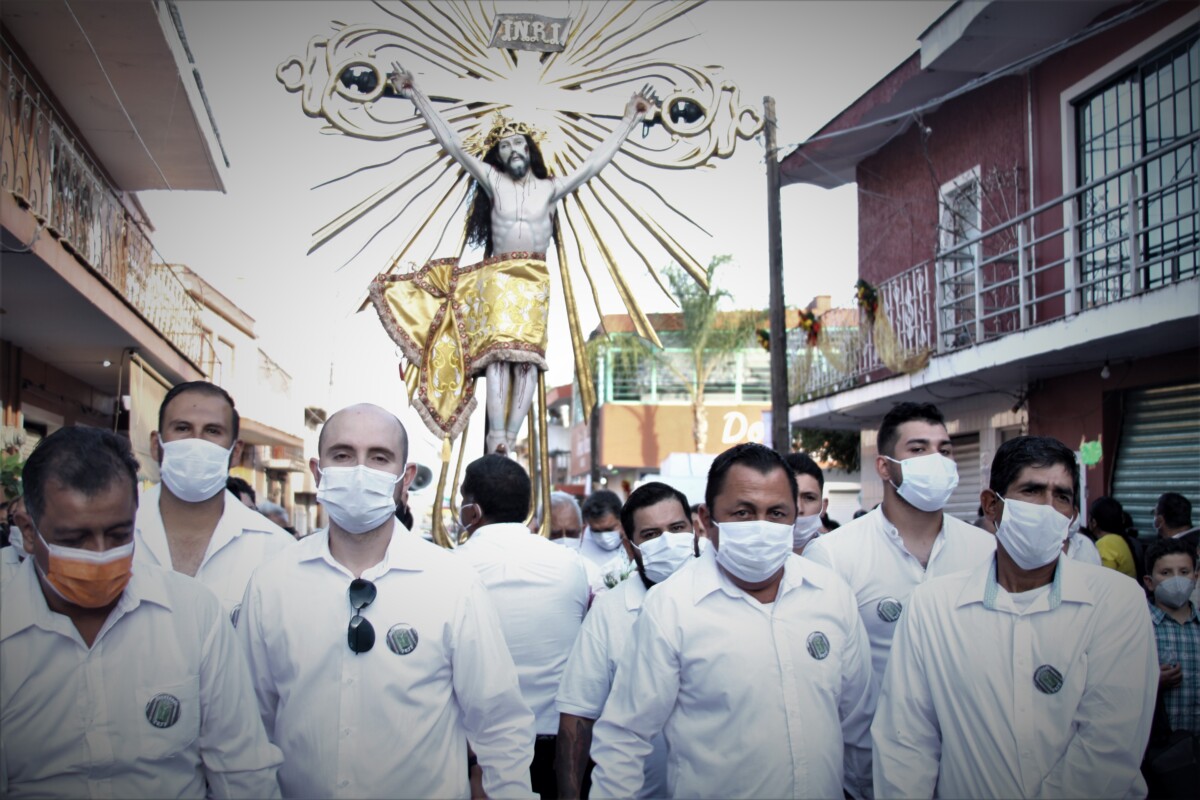
Los cargos para pertenecer a la Guardia de Honor se heredan de generación en generación a los primogénitos.
De aquel día distan ya más de 20 años. Hoy a media hora de que dé inicio la procesión, el atrio comienza a recibir a los peregrinos que siguen llegando, mas no inundan el recinto. Hay a decir de algunos feligreses, la mitad de asistencia a diferencia de los años sin pandemia por Covid-19. Unas cinco mil personas, según datos de la Dirección de Protección Civil del municipio de Jocotepec.
En el templo, ya están a puerta cerrada los miembros de la Guardia de Honor que preparan al Señor del Monte para su recorrido, como ha ocurrido cada tercer domingo de enero desde hace más de 180 años.
El cronista jocotepense Manuel Flores Jiménez, señala el año 1834 como la primera ocasión que los antepasados le celebraron su “función”, y el 8 de noviembre de 1833 como la fecha en que se congregaron también, para jurar por escrito tomarlo como patrón de sus vidas. En 1918 fue renovado dicho juramento.
La Guardia de Honor está compuesta únicamente por varones, todos, descendientes directos de aquellos personajes que hicieran el juramento. Son unos 150; la mayoría adultos, el más pequeño tiene 11 años de edad. Están agrupados por familias; cada una con una tarea específica como organización, preparación de la imagen para su recorrido y cuidado y custodia del patrono durante la procesión.
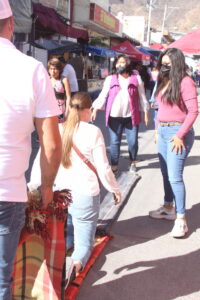
Algunas personas avanzan al encuentro de la procesión hincadas de rodillas para agradecer los favores recibidos o solicitar el auxilio del Señor del Monte.
Pertenecer a la Guardia de Honor es un privilegio que se hereda de generación a generación y se convierte en un regalo que llega por destino.
Los hombres de la Guardia de Honor están vestidos con camisas blanquísimas, rodean a la imagen que ya ha sido bajada del altar y terminan de prepararla para su caminata. En el lugar hay pocas mujeres; no llegan a diez, son familiares directos de los integrantes de la Guardia de Honor. Fue hasta hace unos diez años que comenzó a permitirse el ingreso a las mujeres.
Ya está abajo, el Señor del bautisterio, así lo llamaban los antepasados antes de convertirlo en su patrono, según los registros del cronista Flores Jiménez.
El Cristo, dirige la mirada al cielo con los labios entreabiertos, es de una nariz afilada, con barba y cabellera negra. Tiene los brazos extendidos sobre la cruz de madera que aparece reluciente; esa cruz “morena de sol” como la llama el padre Benjamín Sánchez en el Romancero de la vía dolorosa, está bordeada de rayos dorados.
El Señor del Monte lleva puesto un cendal cobrizo con ricos bordados y en la cabeza, una corona esplendorosa hecha de rezos y plegarias siempre escuchadas, porque “este Señor es muy prodigioso”.
-Yo soy uno de sus milagros- Me dice Manuel Ibarra, quien salió victorioso de un diagnóstico de cáncer. Previo a internarse en un hospital, imploró al Señor del Monte por su salud y tocó con un trozo de algodón el cuerpo del crucificado, para llevarlo consigo en la batalla contra la enfermedad. De ello hace ya 12 años.
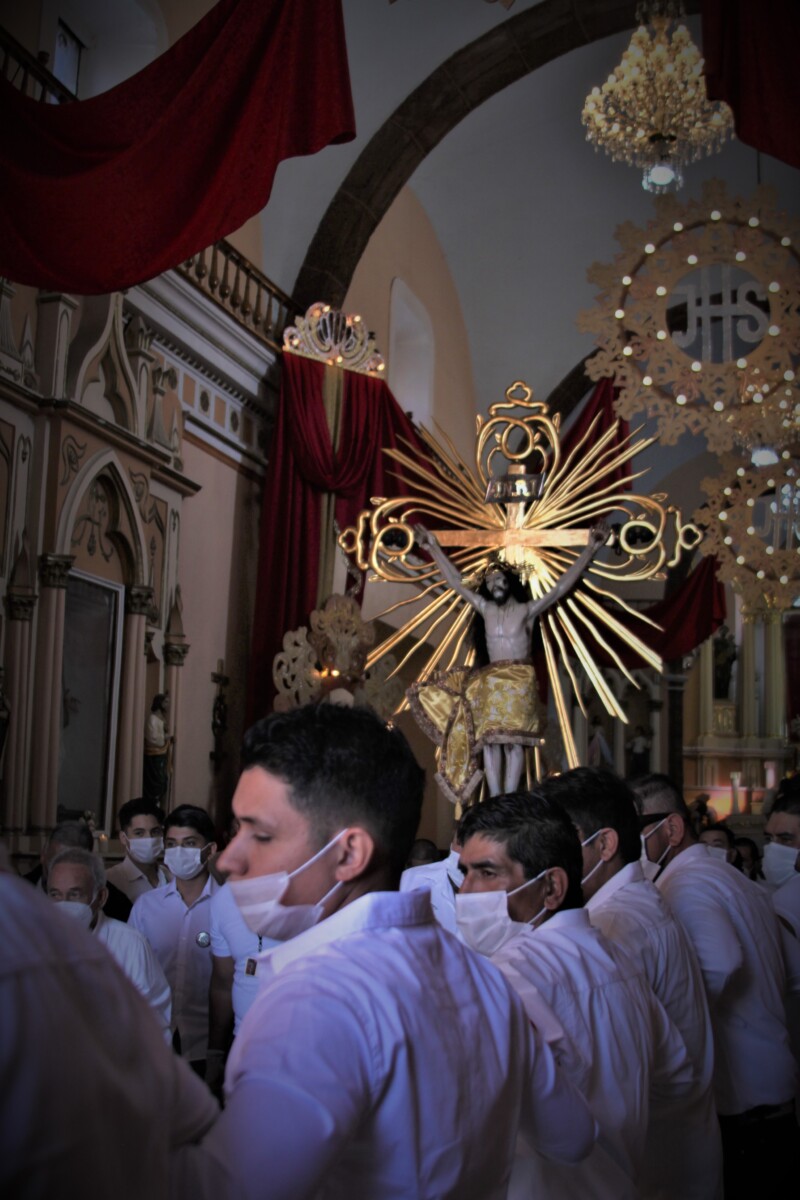
Los hombres de la Guardia de Honor se entrelazan de las manos para salir del templo con la imagen en el inicio del recorrido.
Jesús Pérez es nieto de Cándido Pérez, el último estuvo presente en aquel juramento histórico y aparece en una pintura, “El juramento” que se encuentra en la sacristía de la parroquia. Ahora el señor Jesús participa al lado de su hijo Óscar Pérez y su nieto Alejandro Pérez.
A minutos de comenzar, las campanas doblan con sabor a fiesta, empieza a conformarse una valla humana y las decenas de ojos miran ansiosos la enorme puerta de madera.
-¡Viva el Señor del Monte!- Grita la voz de un hombre secundada por otra voz femenina.
-¡Viva!-
Responden las voces fervorosas y se abre la puerta.
Los fieles se aglomeran al encuentro del Cristo crucificado. Suenan los tambores de los danzantes y comienza el peregrinar.
Encabezando la procesión va una niña de unos cinco años con atuendo de danzante, emula los pasos de sus mayores y se desliza segura a lo ancho de la calle.
Un hombre y una mujer llevan unas playeras blancas, “Danza por manda” se lee en letras negras, con ellos van formadas más personas que danzan durante todo el recorrido, formadas en filas ordenadas. También va la banda de guerra, un joven con zancos que ayuda con el orden de los caminantes y un mariachi.
Una voz femenina reza el rosario desde un carro con una bocina y canta.
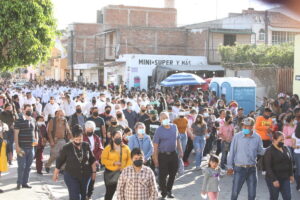
Algunas calles están adornadas con moños de listón satinado rojo y amarillo, también con arcos de flores frescas.
El Señor del Monte va cargado por una guardia de 20 hombres, uno de ellos camina de espaldas, cada cierto tiempo a lo largo de la caminata se intercambian por otro grupo de 20. Se hacen cinco guardias a lo largo del peregrinar, en total son cien hombres los que cargan al santo patrono.
Los “vivas” al Señor del Monte se escuchan a lo largo del recorrido, los ojos llorosos buscan el rostro del crucificado, hay muchas lágrimas derramadas, cuantiosas plegarias en silencio, que se anuncian con la mirada lacrimosa de los que salen a su paso.
Algunas personas van descalzas y con los ojos vendados; una fila de hombres y mujeres que avanzan hincados de rodillas en sentido contrario a la procesión, van al encuentro de la imagen, apoyados en cobijas dobladas que les tiran en el piso.
Los oficiales de Protección Civil vigilan a los que van hincados y les ayudan a levantarse.
Los uniformes caqui de los oficiales y sus cascos amarillos se mezclan con los trajes de brillantes botonaduras de los mariacheros y las blancas camisas de los guardianes de la fe.
Oficiales, fieles, músicos y sacerdotes convergen en una procesión ancestral, dedicada a aquel antiguo Señor del bautisterio que convoca a miles porque su presencia irradia un no sé qué.
Con animadas celebraciones religiosas fue como volvió el festejo a San Sebastián
San Sebastián sobre su anda, saliendo del barrio de San Sebastián, ubicado en la parte norte de la delegación de Ajijic.
Sofía Medeles (Ajijic, Jal.)- Pese a que se celebró a San Sebastián con una ceremonia muy modesta, los vecinos del barrio no perdieron oportunidad para festejar al Santo, con una misa en el barrio ubicado al norte de Ajijic, conviviendo con chocolate caliente y pan, y en la tarde, con una pequeña procesión para devolver a la figura religiosa, amenizada con una agrupación musical y las tradicionales sayacas.
Durante la mañana, en la misa no asistieron más de 50 personas y todas respetaron en todo momento los protocolos de salud vigentes. Al finalizar se repartió chocolate, canela y pan tachihual para los participantes de la ceremonia eucarística. “Estuvo bien, fue chiquita a diferencia de otros años, pero se sintió igual de bonito”, mencionó don Antonio, vecino cercano del barrio.
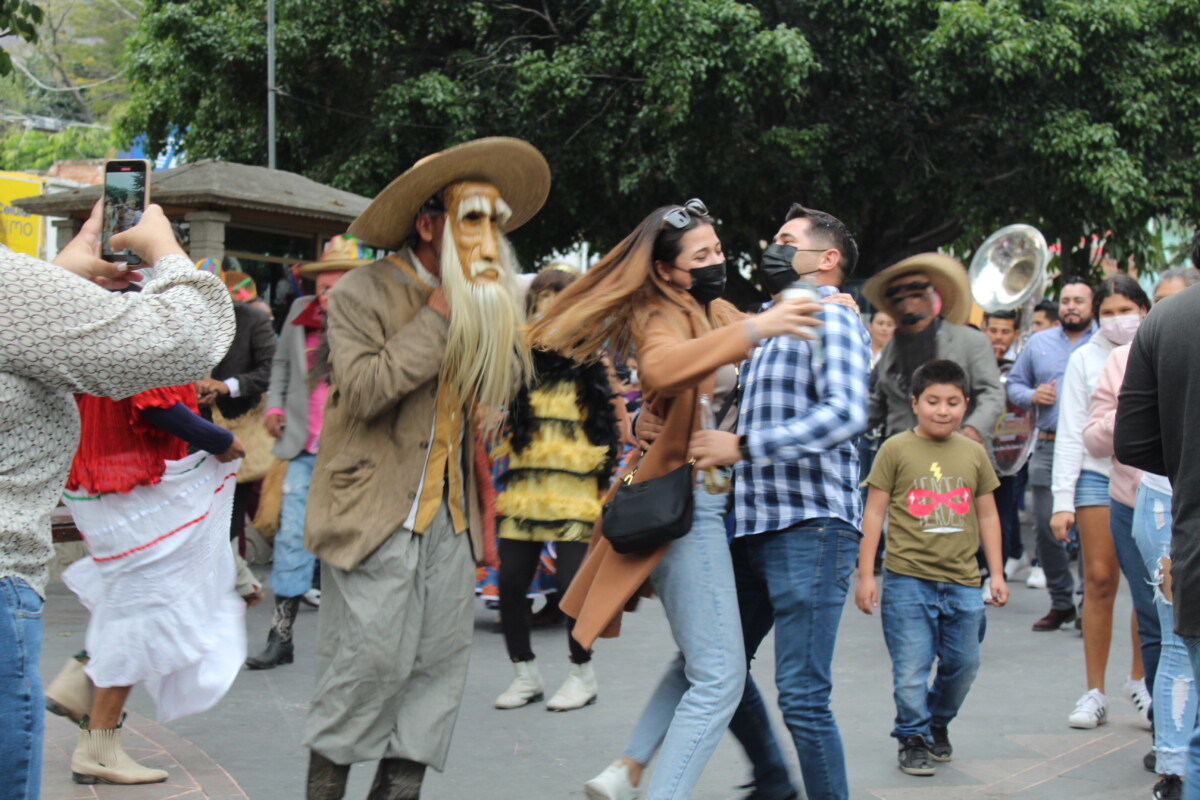
Una pareja de turistas se unió al baile de las sayacas que acompañaron a San Sebastián en su recorrido por algunas calles de Ajijic.
Más tarde, durante la procesión, se pudo ver más gente -aproximadamente 70 personas-. La procesión inició con las sayacas bailando, mientras detrás de ellos iba una agrupación musical, y al final, San Sebastián, cargado por cuatro hombres.
A lo largo de la procesión, hubo un grupo de niños que buscaban ser perseguidos y enharinados por las sayacas, quienes solo se limitaron a bailar, y a su alrededor, espectadores que disfrutaban el festejo mientras grababan.
“Esto es lo que le gusta a uno, ya ha habido tantos festejos tan grandes, como el de Joco, no creo que hagan escándalo por esto. Aquí hay puros vecinos y todos con nuestros cubrebocas. Ya nos dimos el gusto de convivir y además compartir una cervecita”, aseguró don Nico, minutos antes de iniciar la procesión.
Aunque el recorrido cambió un poco -por las calles de Zapata, Javier Mina, Guadalupe Victoria, una vuelta por la plaza, y finalmente la calle Parroquia- estuvo todo el trayecto acompañado de espectadores. En la plaza, un par de turistas emocionados, se unieron a la procesión a bailar con la música de la banda.
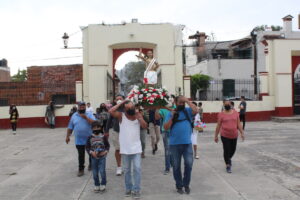
Entrada de la procesión a la parroquia de San Andrés Apóstol, donde finalmente fue dejada la imagen del santo.
“No nos imaginábamos que iba a haber un desfile, solo vinimos a dar la vuelta porque hubo chance. A San Sebastián no lo conocíamos, mucho menos imaginábamos que aquí en el Pueblito Mágico es tan querido”, mencionó un señor que estaba sentado en la plaza.
Al final, a la parroquia de San Andrés Apóstol donde fue llevado el santo, solo entraron quienes cargaban a la imagen, así como unos pocos acompañantes, mientras las sayacas se quedaron a la entrada de la parroquia, y la banda tocando las mañanitas afuera del templo. Tras dejarlo, las personas regresaron al barrio de San Sebastián, ubicado al norte, en Ajijic.
Chapala Musicians’ Guild Reports Good Winter Season
Members of Mariachi Centenario de Chapala (from left to right): Eric Serna, Ramón Úlises and Brandom.
Jazmín Stengel, Ajijic (JAL)-At an informal meeting between Laguna Seminario and members of the Chapala Musicians’ Guild, the mariachi “Centenario de Chapala” group’s trumpet player, Eric Serna, said «It [this season] wasn’t the best, but it was better than last year.»
Among mariachi groups that work on the malecón and Chapala tourist area such as the groups “Centenario,” “Aguila,” and “Norteño Los Alacranes,” group members mentioned having earned up to a thousand pesos a day per person during the winter season. Each mariachi group charges 250 pesos per song to the general public. Groups usually consist of five to seven musicians. The good season began in November; however, during the holidays «we even get tired of working,» Serna added.
The situation in Chapala has improved to such an extent that Serna and his colleagues have preferred to remain in Chapala instead of traveling to Puerto Vallarta as they usually do during the low season. On the other hand, the soloists working in downtown Ajijic and the surrounding restaurants considered December as having been the lowest month of the season, although in January «people have been more splendid,» agreed three area guitarists. This was echoed by merchants of the Tianguis Navideño [merchants who sold their merchandise in Chapala’s plaza last holiday season], who complained about the low sales during the winter holidays for businesses of all sizes.
Translated by MaryAnne Marble
© 2016. Todos los derechos reservados. Semanario de la Ribera de Chapala
